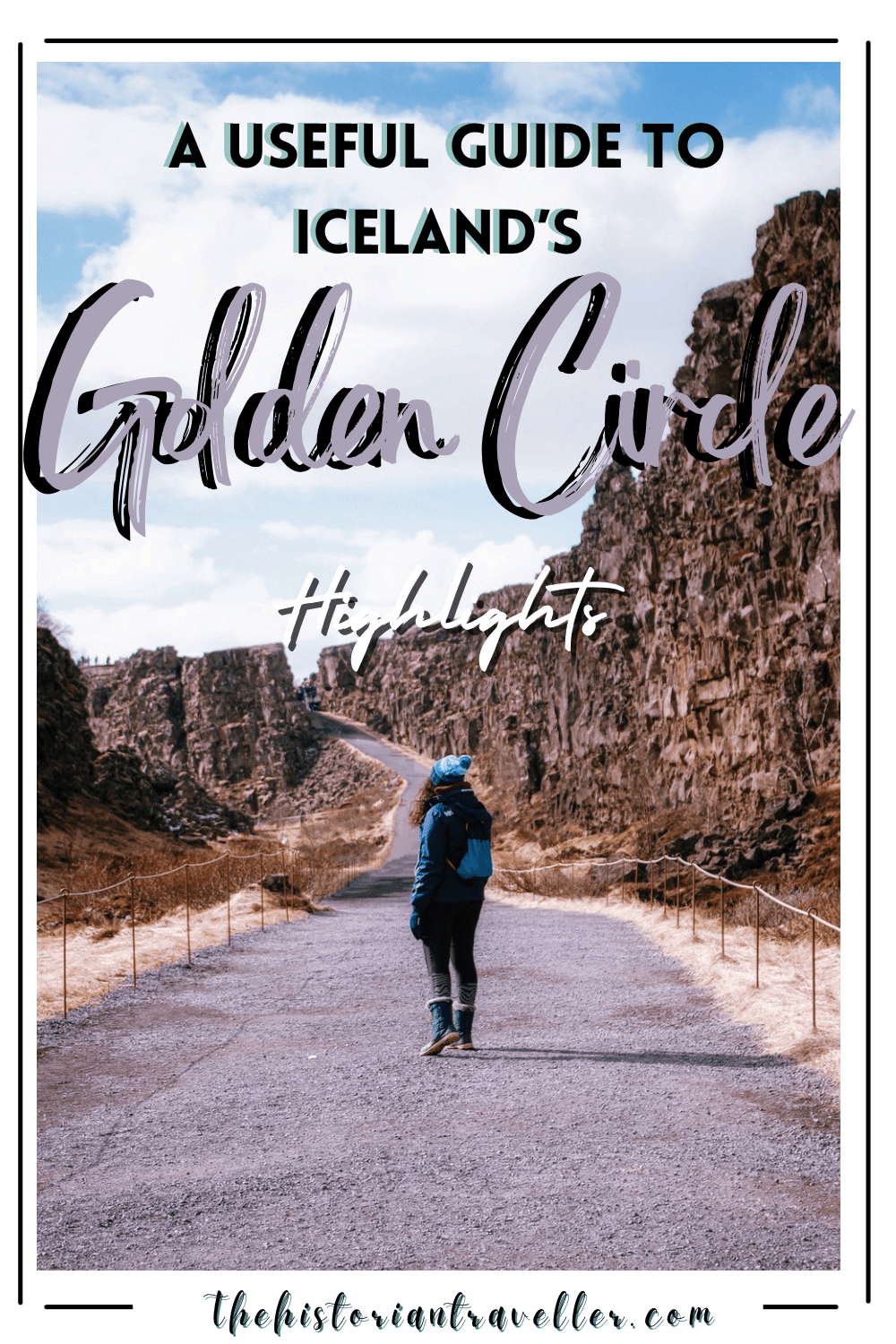Last Updated on November 3, 2023 by
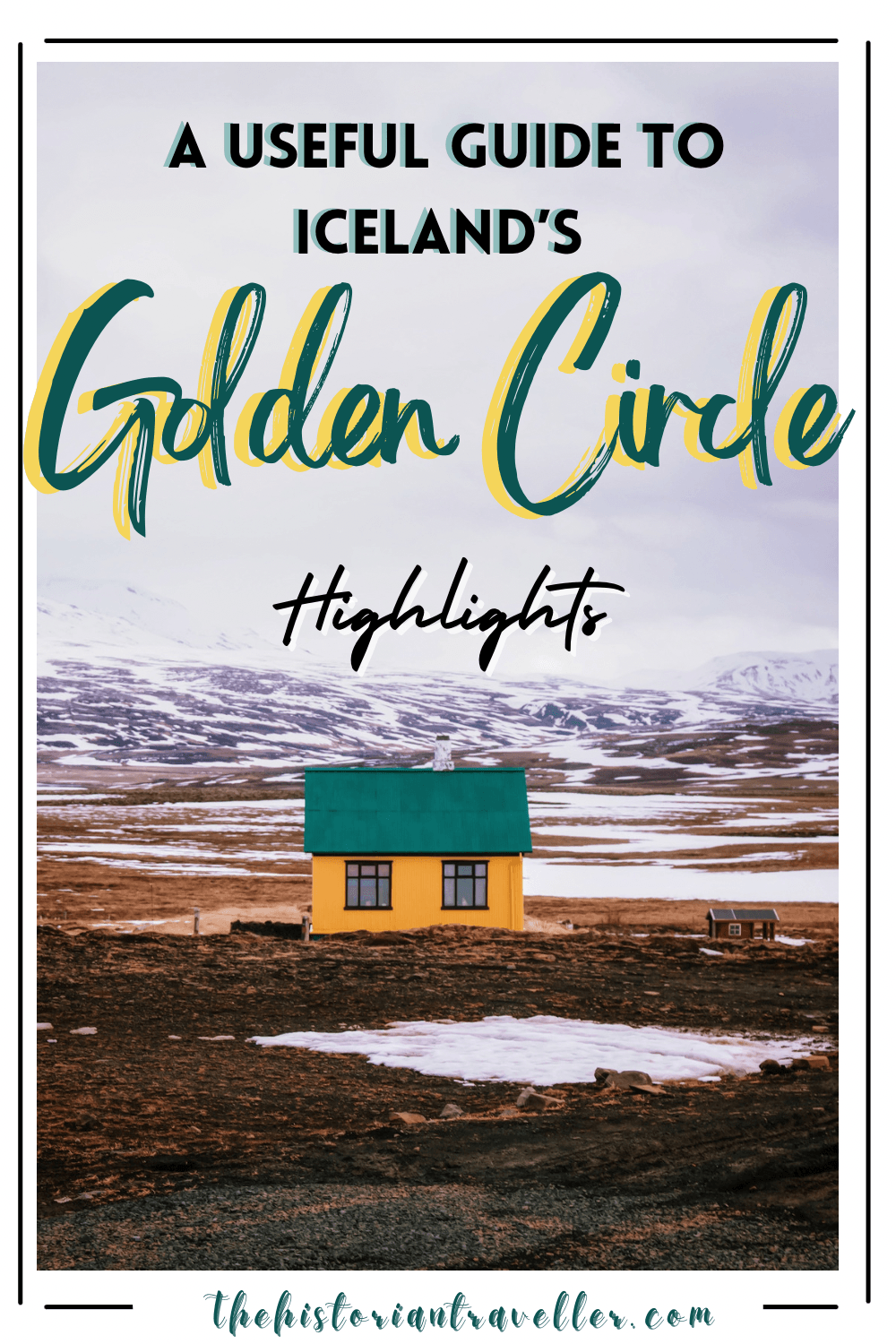
When it comes to Icelandic adventures, the “Golden Circle” stands out as the most well-trodden tourist route in this breathtaking country. Whether you’re planning a short stay or an extended visit to Iceland, exploring Reykjavik and embarking on the Golden Circle route will undoubtedly be some of the best highlights of your journey. In this comprehensive guide, I will unveil a valuable Iceland Golden Circle itinerary that will empower you to traverse Icelandic roads with confidence, ensuring you’re well-prepared to discover the main attractions of the Golden Circle.
Table of Contents
Information about the Golden Circle in Iceland
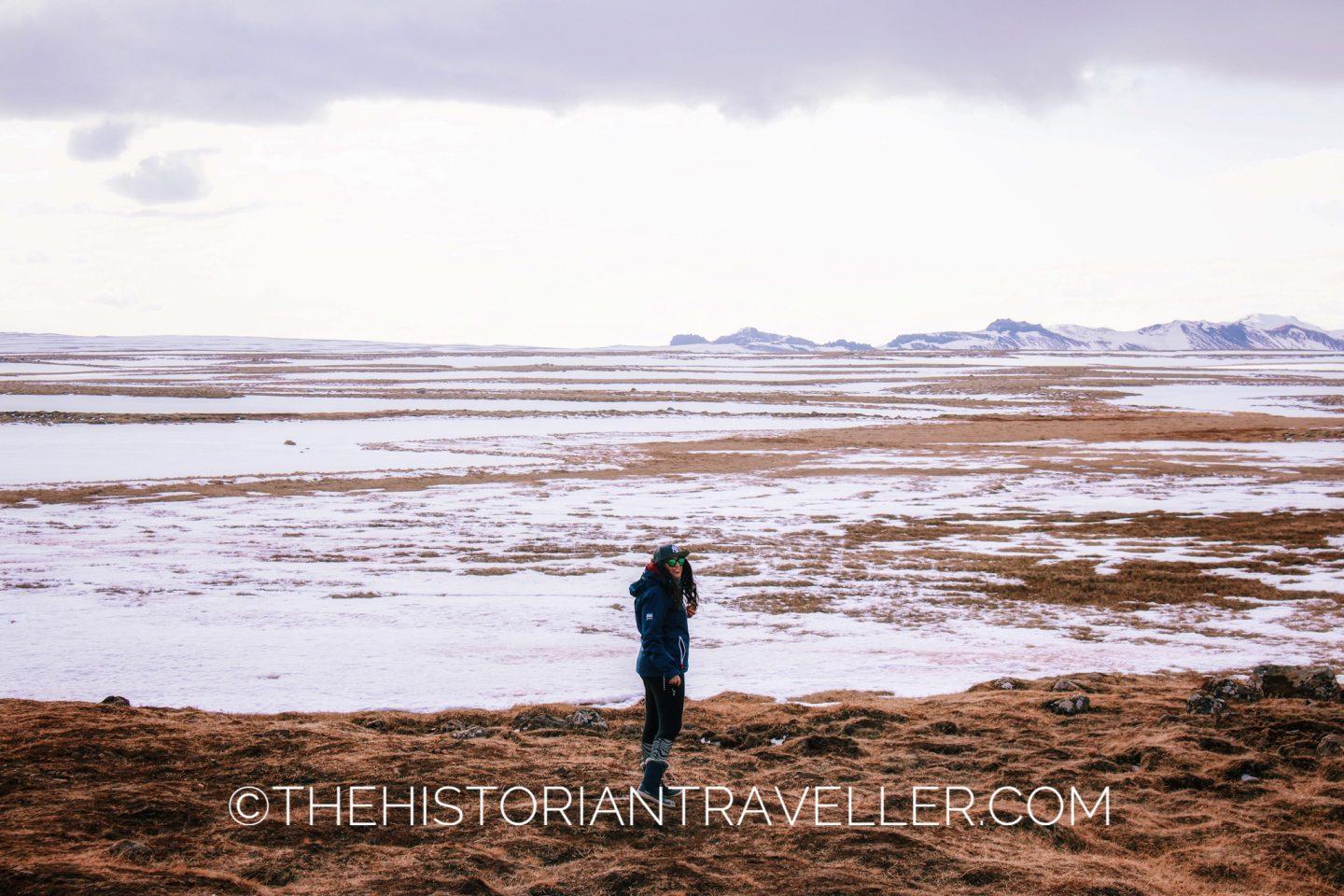
Why is called Golden Circle?
Before embarking on your epic drive along the Icelandic Golden Circle, you might be interested in some background information about this incredible route. The original name of the route, “Gullni hringurinn,” refers to the path that leads from Reykjavik to Gullfoss, creating a circular journey. In fact, the term “gold” specifically refers to the Gullfoss waterfall, which translates to “Golden Waterfall.”
What is the difference between Golden Circle and Ring Road Iceland?
For people who never been to Iceland or are unfamiliar with the nation’s geography, it’s easy to confuse the Golden Circle route with the Ring Road. Nevertheless, these are two completely different itineraries (despite overlapping in two or more points).
In fact, as said before, the Golden Circle is the road that loops from Reykjavik to Gullfoss. Differently, the Ring Road, (otherwise known as Route 1), is the route that encircle the entire country starting from Reykjavik but excluding the Vestfirðir (the West Fjords region), a large peninsula in northwestern Iceland.
One of the main differences between the two roads is that you can easily complete the Golden Circle in one day (or two if you want to go slower), the Ring Road usually requires 5 to 7 days to complete.
What is the length of the Golden Circle?
Despite including many beautiful natural attractions, the Golden Circle’s route is relatively short. In fact, the whole itinerary loops from Reykjavik for about 300km (186 miles).
How many days should I spend in the Golden Circle?
Due to its relatively short length, the Golden Circle is ideal for a day trip or a short stay lasting 1 to 2 days, especially if you don’t want to rush through the experience. Since my husband and I have planned an entire week to explore the main Ring Road, we made the decision to dedicate just one day to visiting the key attractions on the Golden Circle.
Tips for visiting the Golden Circle
Here are some valuable tips for your visit to the Golden Circle:
- Start Early at Þingvellir National Park: Begin your journey early at Þingvellir National Park. Places tend to fill up with people quickly, and experiencing Þingvellir without a crowd is an entirely different experience.
- Allow Sufficient Time for Exploration: Ensure you have ample time to explore each location, especially if you’re there for photography. Budgeting around 1.5 hours per spot should be sufficient.
- Bring Waterproof Clothing and Gear: Be prepared with waterproof clothing and camera gear, as you’re likely to get wet at Geysir. Wear comfortable waterproof shoes, as you’ll be doing a lot of walking, and Icelandic weather can be unpredictable.
- Plan your Lunch stop in Advance: Plan ahead for lunch, as there aren’t many dining options along the way. Therefore research in advance your lunch stop and make a reservation if necessary to avoid any disappointment.
- Parking Fees: Keep in mind that while the natural attractions on the Golden Circle, with the exception of the Kerid Crater, are free, you may have to pay for parking if you’re traveling by car.
These tips will help you make the most of your Golden Circle adventure and ensure a comfortable and enjoyable experience.
Iceland golden circle itinerary highlights
The map above provides a detailed overview of the exact itinerary my husband and I followed for our Golden Circle route. As I mentioned earlier, our route covered the primary highlights, as we were planning to continue south to start Route 1 after the last stop, rather than returning to Reykjavik. We independently organised and executed this itinerary, opting not to go with an organised tour operator.
The primary highlights of the Golden Circle include Þingvellir National Park (or Thingvellir), the Geysir Geothermal Area, and the Gulfoss Waterfall. Even if you choose an organized tour, these three destinations will likely be the main stops on your journey. Any additional stops are usually included if there is extra time available. Further information about these additional stops can be found at the end of this blog.
For our personalised itinerary, we added a bonus stop to interact with the friendly Icelandic Horses along the way. This was our first stop because the farm was conveniently located near Reykjavik. If you’re not particularly interested in horses, you can simply skip this step and head directly to Þingvellir National Park.
The total length of our route covered 117 km, making it a manageable and rewarding day trip.
First stop – meeting the Icelandic horses!
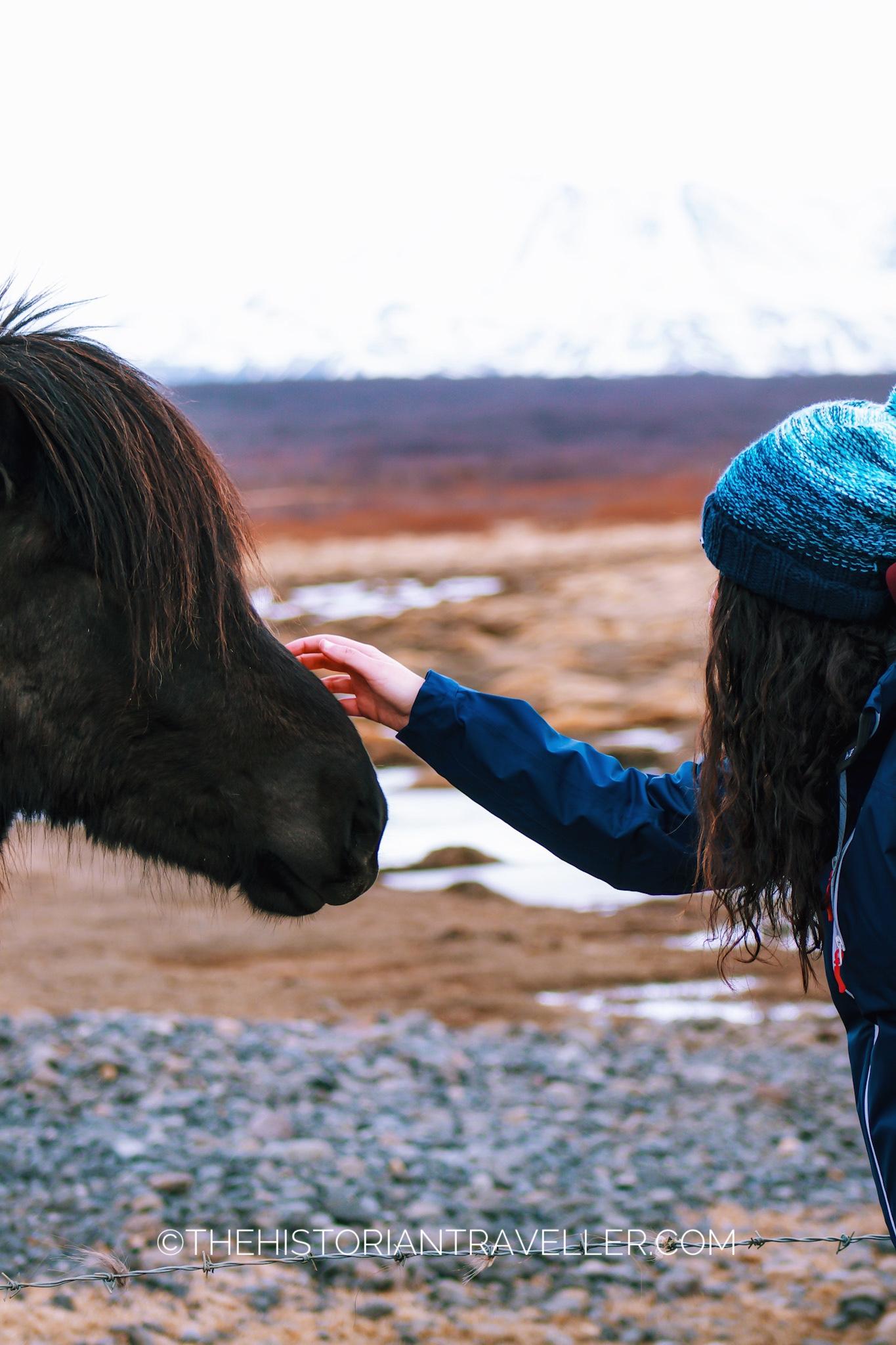
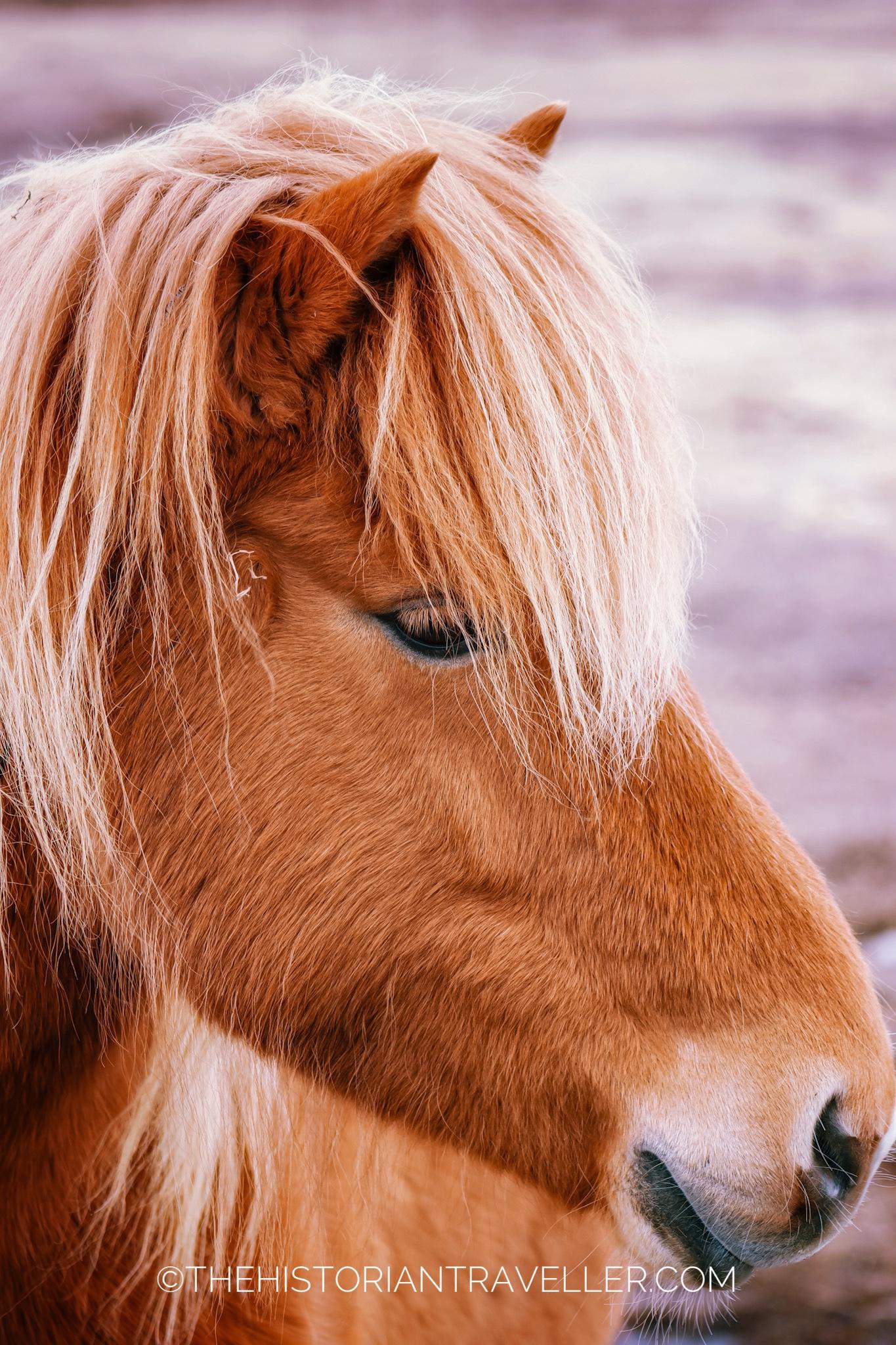
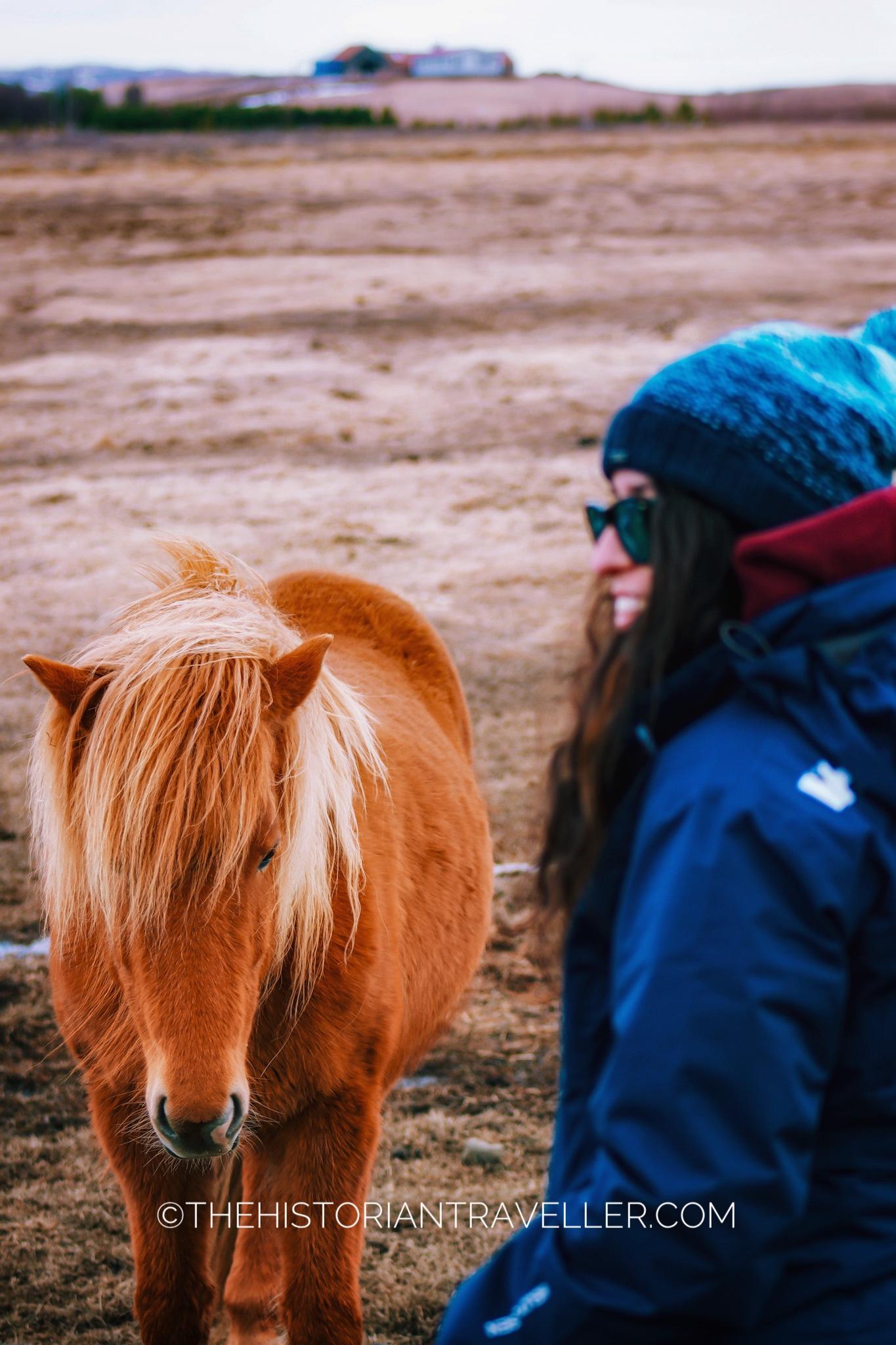
Photographing the Icelandic Horses was a highlight on my own itinerary, and I highly recommend it to anyone visiting Iceland. These unique horses can be found all over Iceland, but along the Golden Circle route, you’ll come across numerous farms where they graze by the side of the road, making it much easier to get up close and spend some time with these beautiful creatures. A nice place to stop if you have some spare time is the Laxnes Horses Farm (first stop on the map). They also organise some day tours. The photos above have been taken from the side of a road shortly after Reykjavik. There was not farm sign but there were some fences which, of course, we didn’t cross.
Icelandic Horses and Norse Mythology
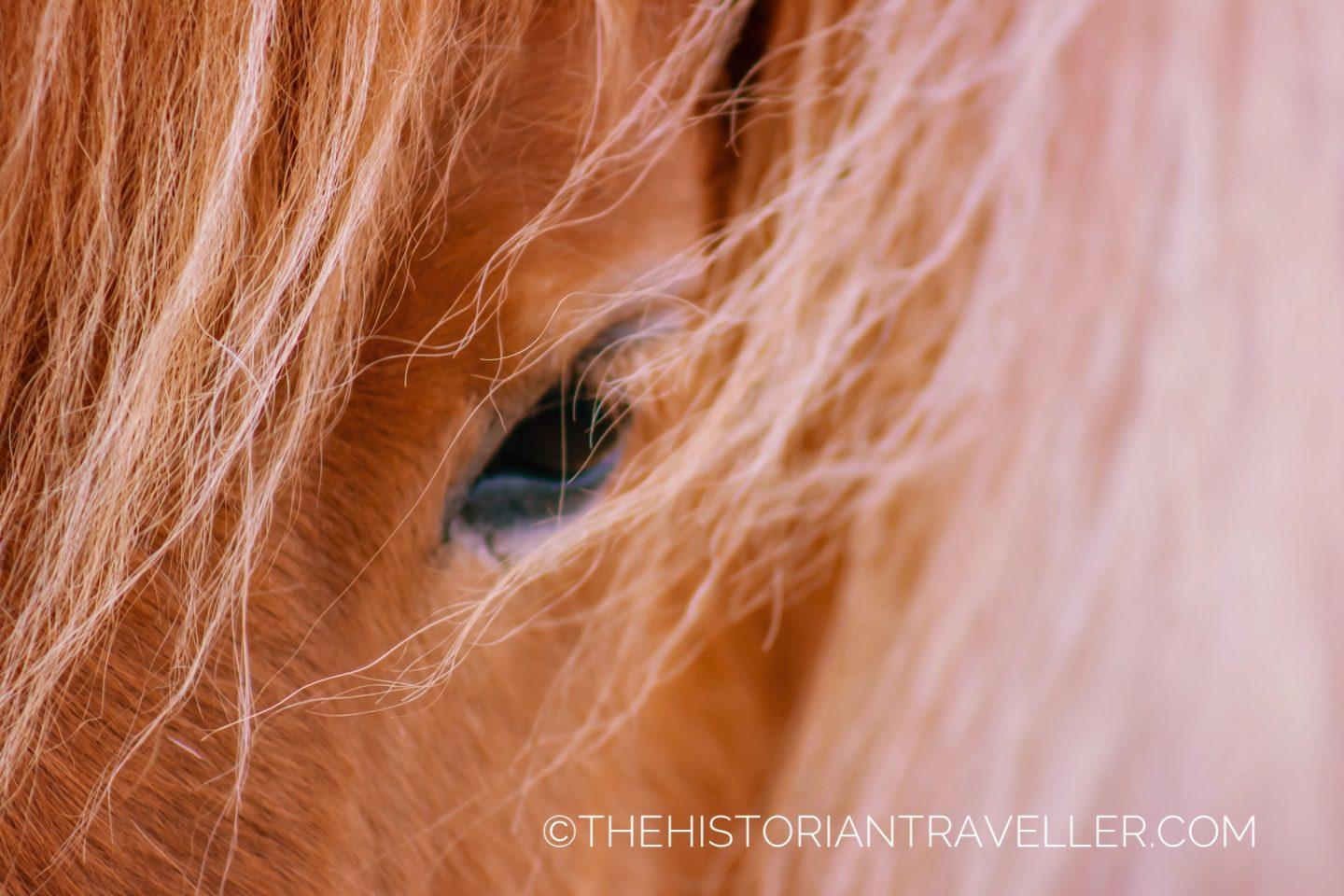
Icelandic Horses were originally brought to Iceland by the Vikings during the early Middle Ages. While the current breed is slightly different from the horses of that time, they still represent a symbol of that special traditional heritage. The Vikings held horses in high regard and considered them sacred animals, as they played significant roles in Norse mythology. Some were protectors, while others were symbols of fertility. Perhaps the most famous mythological horse is Sleipnir, the eight-footed horse beloved by the god Odin.
Today, most Icelandic horses are used by Icelanders for agricultural work or in competitions. They are treated with great care and affection. From what I’ve observed, many farmers and owners consider them an integral part of their families.
So, don’t miss the opportunity to interact with these remarkable horses during your Golden Circle adventure. It’s not just a chance for photography but also to connect with a piece of Iceland’s rich history and culture.
Tips for your Icelandic Horses meeting
Icelandic horses are known for their friendly and sociable nature, as they are accustomed to human company. However, there are a few important considerations when interacting with them:
- Beware of Electric Fences: Be cautious when approaching Icelandic horses near fences. Some of these fences are electric, which can be a danger both to you and the horses. Keep a safe distance.
- Don’t Feed Them: While horses may approach you in anticipation of food, it’s advisable not to feed them. You might not be familiar with their usual diet or any special dietary requirements they have.
- Respect Private Farms: Many Icelandic horses are kept on private farms, even though they may appear to roam freely in open landscapes. It’s essential to be respectful of the boundaries and the lives of local people. While Icelanders are generally patient with tourists petting and photographing their horses, it’s important to maintain a considerate and respectful approach.
Second stop, Þingvellir National Park
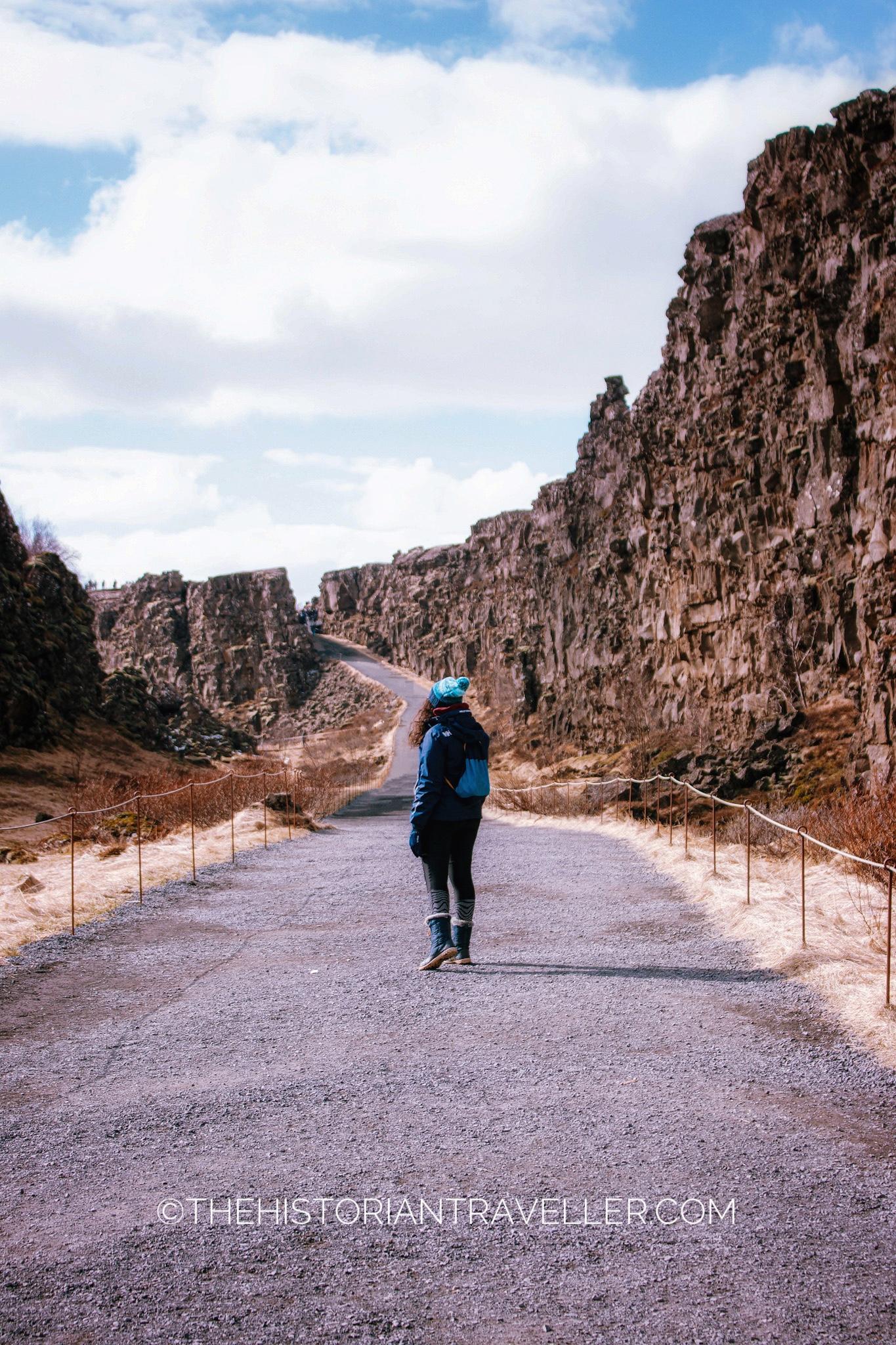
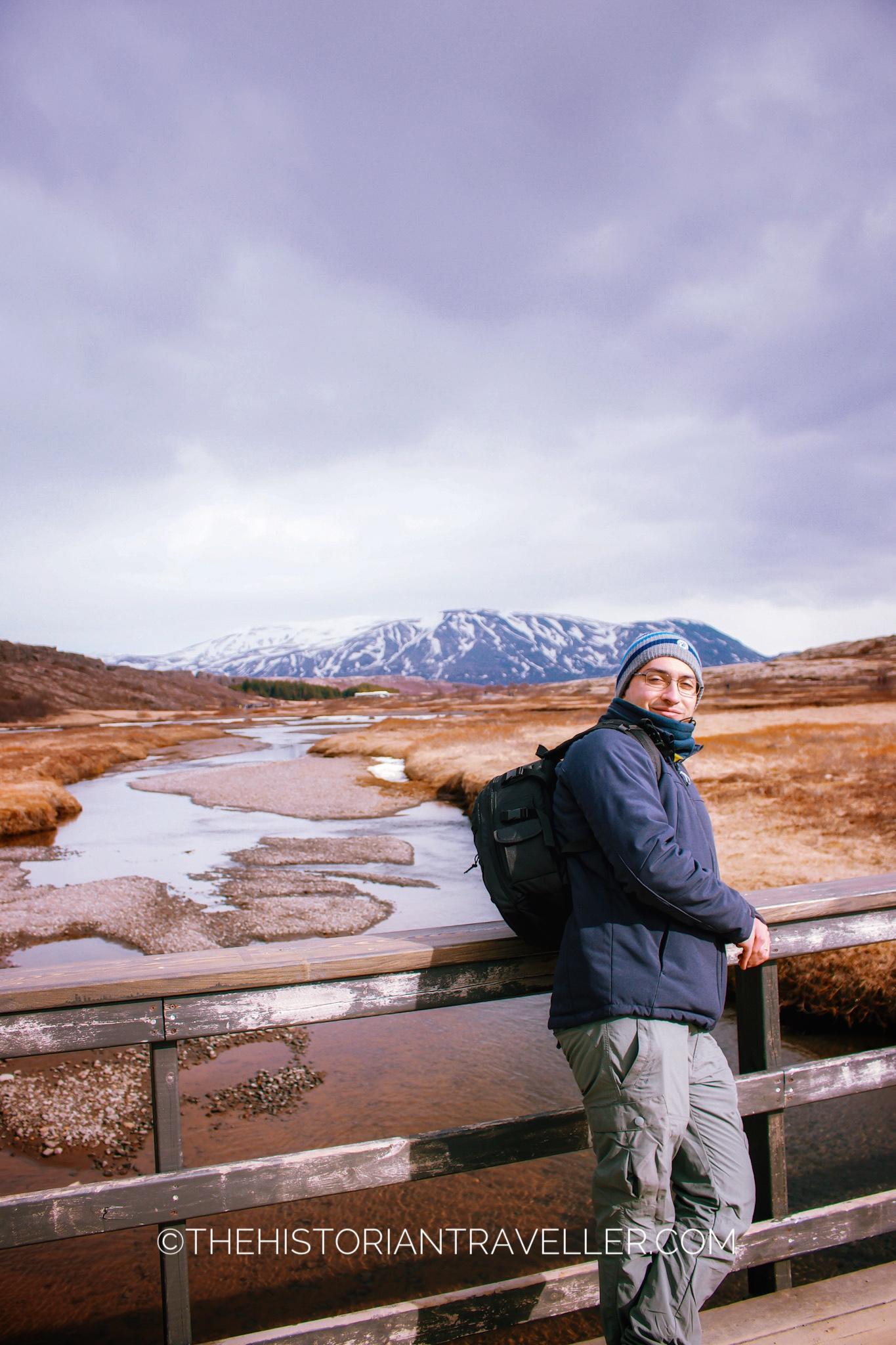
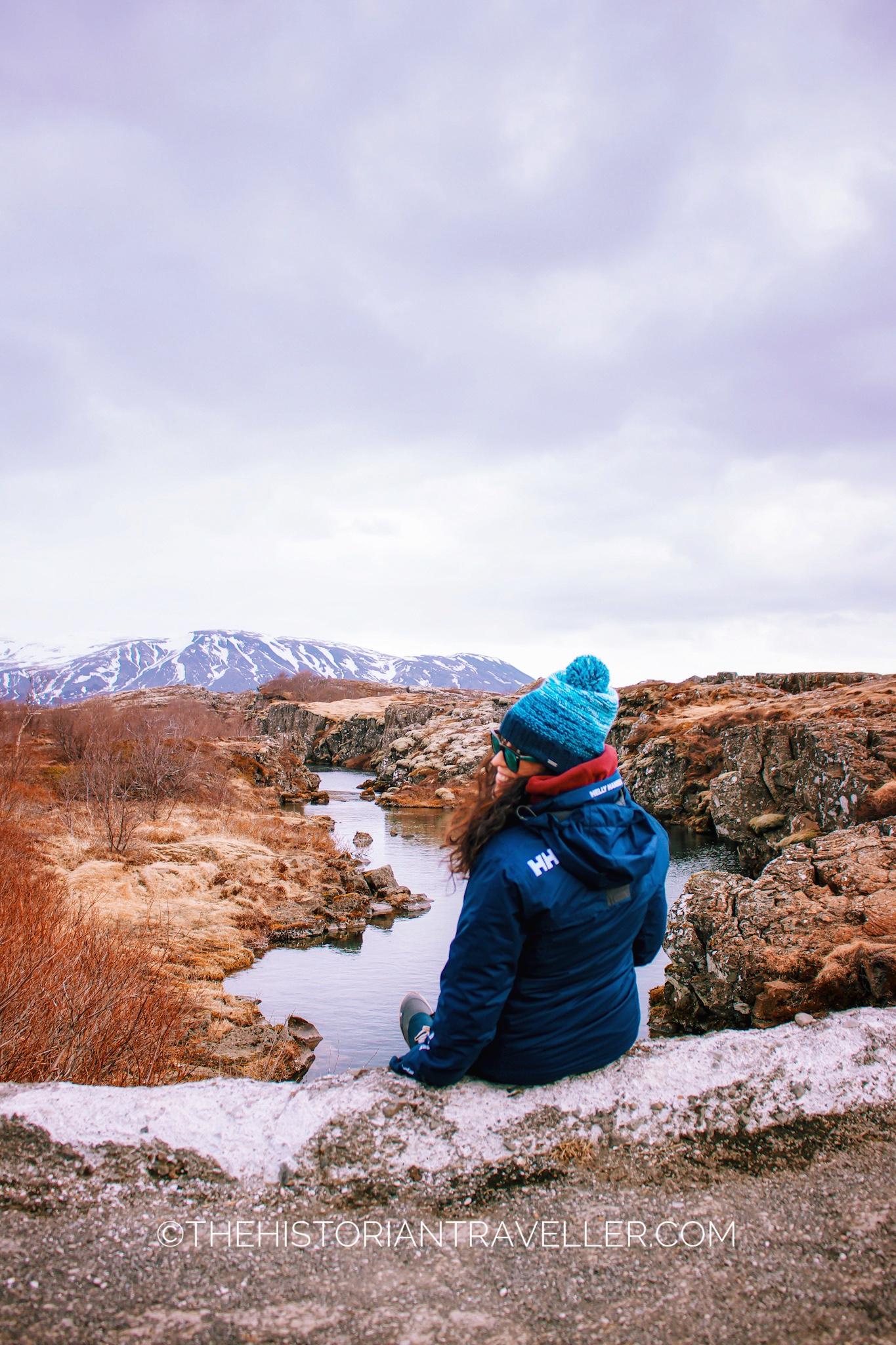
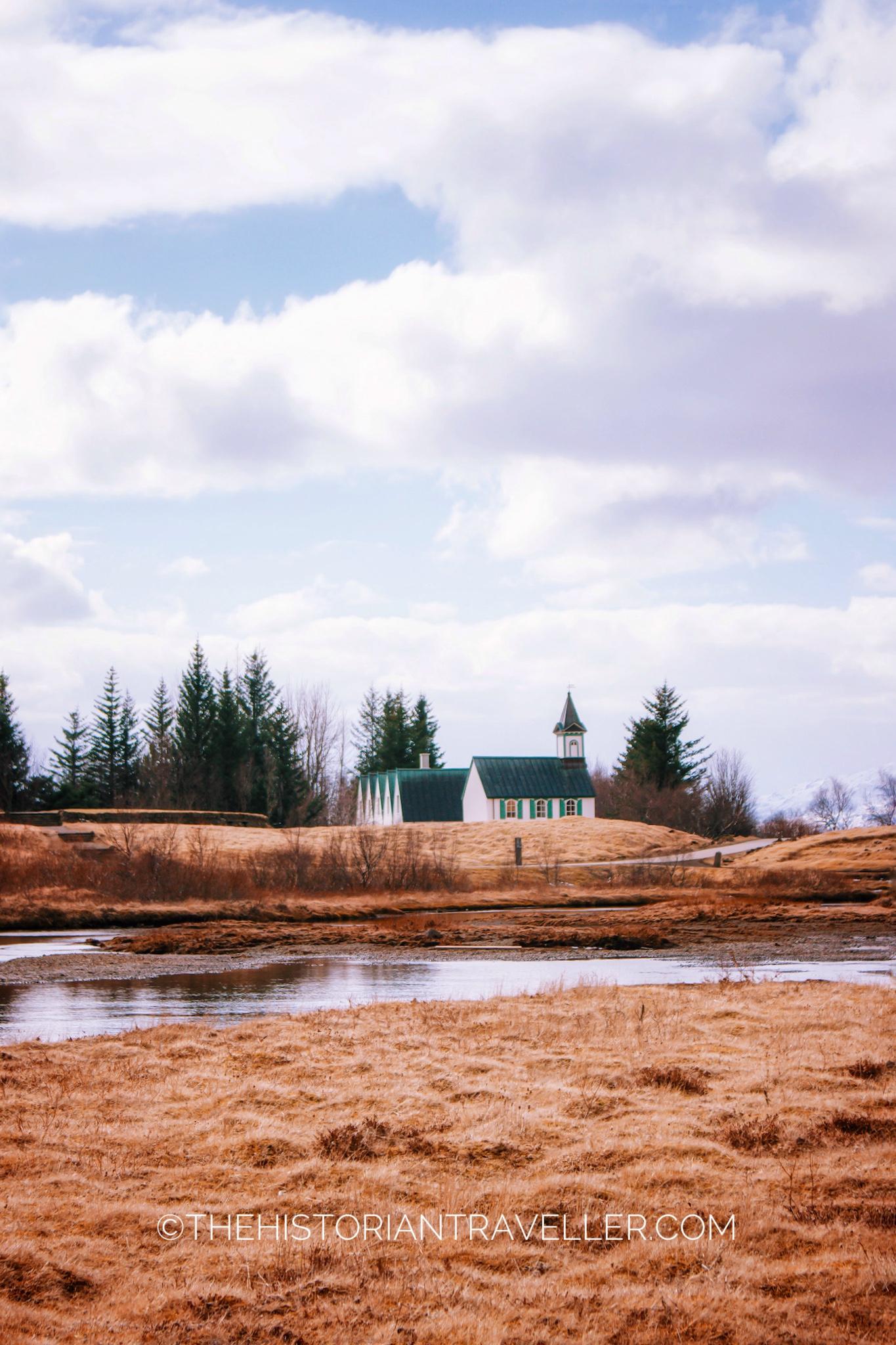
If you choose to skip the horse meeting along the way, Þingvellir can be regarded as the first “official” stop of the Golden Circle for all tours departing from Reykjavik. The distance from the capital to Þingvellir is approximately 40 kilometers, and it takes about 36 minutes to reach the main car park. This makes it a convenient starting point for your Golden Circle adventure. Please note that despite the entrance to Þingvellir is free, the parking slot is chargeable. The price for the parking space is between 400-600 ISK.
Some information about the Þingvellir National Park
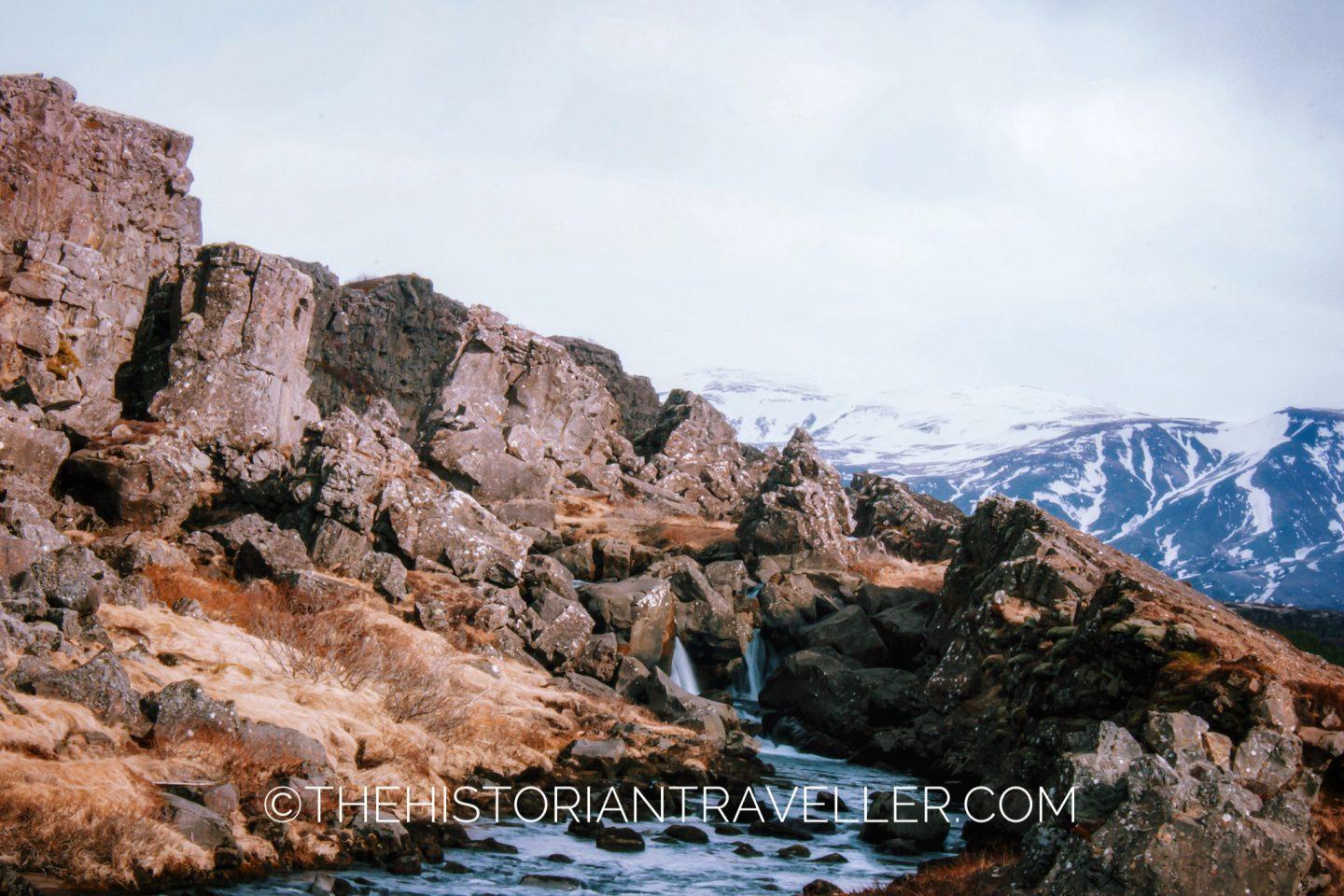
The Icelandic word “Þingvellir” translates to “Parliament.” In historical terms, when the Vikings first arrived in Iceland around 874 AD, they established their parliamentary assembly in what is now a National Park known as Þingvellir. Today, Þingvellir remains a significant location for events of national importance, such as the declaration of Iceland’s independence in 1944, as well as for hosting summer concerts.
Geographically, Þingvellir is situated in a rift valley formed during the separation of the North American and Eurasian tectonic plates. This unique geological setting adds to the site’s historical and natural significance, making it a must-visit destination on the Golden Circle route.
Indeed, Þingvellir National Park is situated precisely between two continents, making it an extraordinary and unique geological wonder. The constant movement of the tectonic plates, drifting apart at a rate of approximately 2 centimetres per year, adds to the park’s allure, showcasing the dynamic forces shaping the Earth’s surface. It’s truly awe-inspiring!
Walking through the Almannagjá Gorge, as pictured, can take around half an hour, provided you don’t (like me) stop every two steps to capture the incredible scenery on camera.
While many visitors tend to explore this side of the park, I highly recommend taking a little detour in the surrounding area if you have the time and don’t mind a walk. The natural beauty of the surroundings is beyond words.
If you’re a fan of “Game of Thrones,” you’ll be delighted to know that Þingvellir National Park served as one of the locations for the TV series, particularly the area near the Öxarárfoss waterfall. It’s a treat for both nature enthusiasts and pop culture enthusiasts alike.
Enhance your Þingvellir visit with a diving experience
If you have some extra time to spare during your visit to Þingvellir, one experience you absolutely shouldn’t miss is the opportunity to go diving at the Silfra fissure. Silfra is an extraordinary geological feature—a fissure in the Earth created by the movement of the North American and Eurasian tectonic plates. This unique location is renowned for its crystal-clear glacial water, offering over 100 meters of underwater visibility.
Please note that in order to do this experience, you must have a PADI certification course. If you don’t have a PADI certification, you can opt for a snorkelling tour, which doesn’t require any certification.
Tour prices for diving starts at £200 per person for a 40 mins dive. While snorkelling tours starts at £115 per person. Most of the divings and snorkelling tours are organised by Diving.is.
Third Stop – See the geysers at Geysir
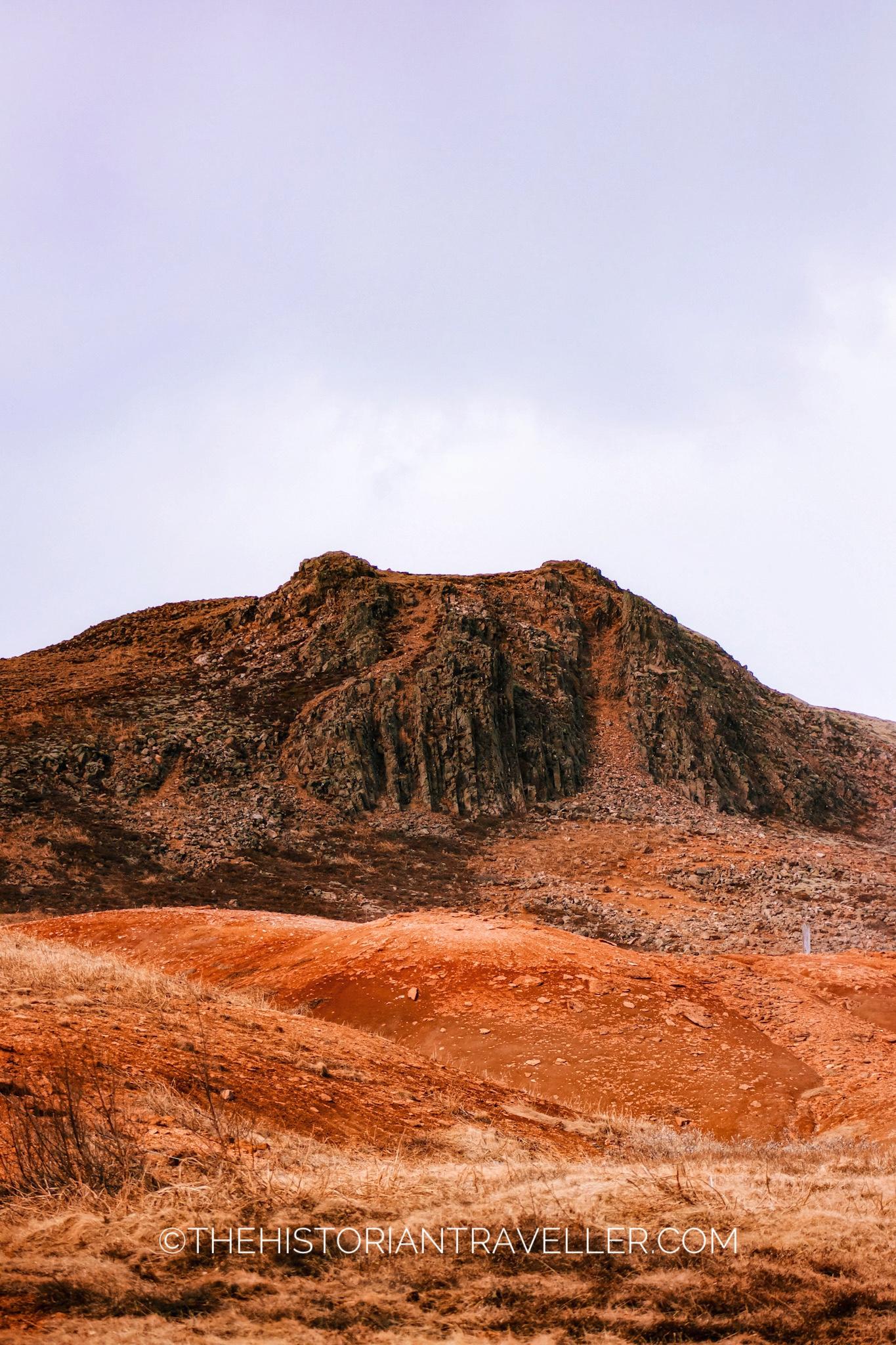
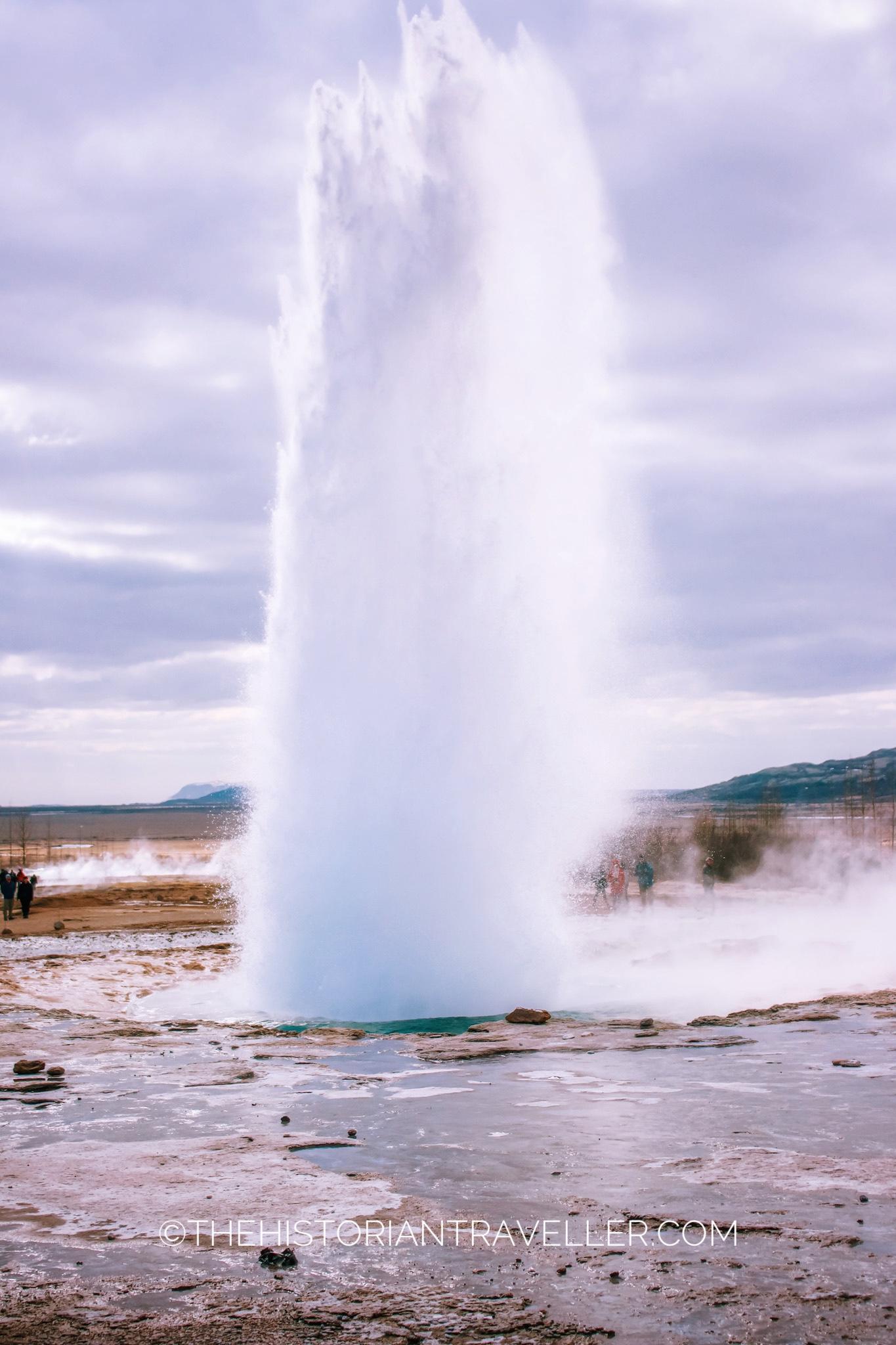
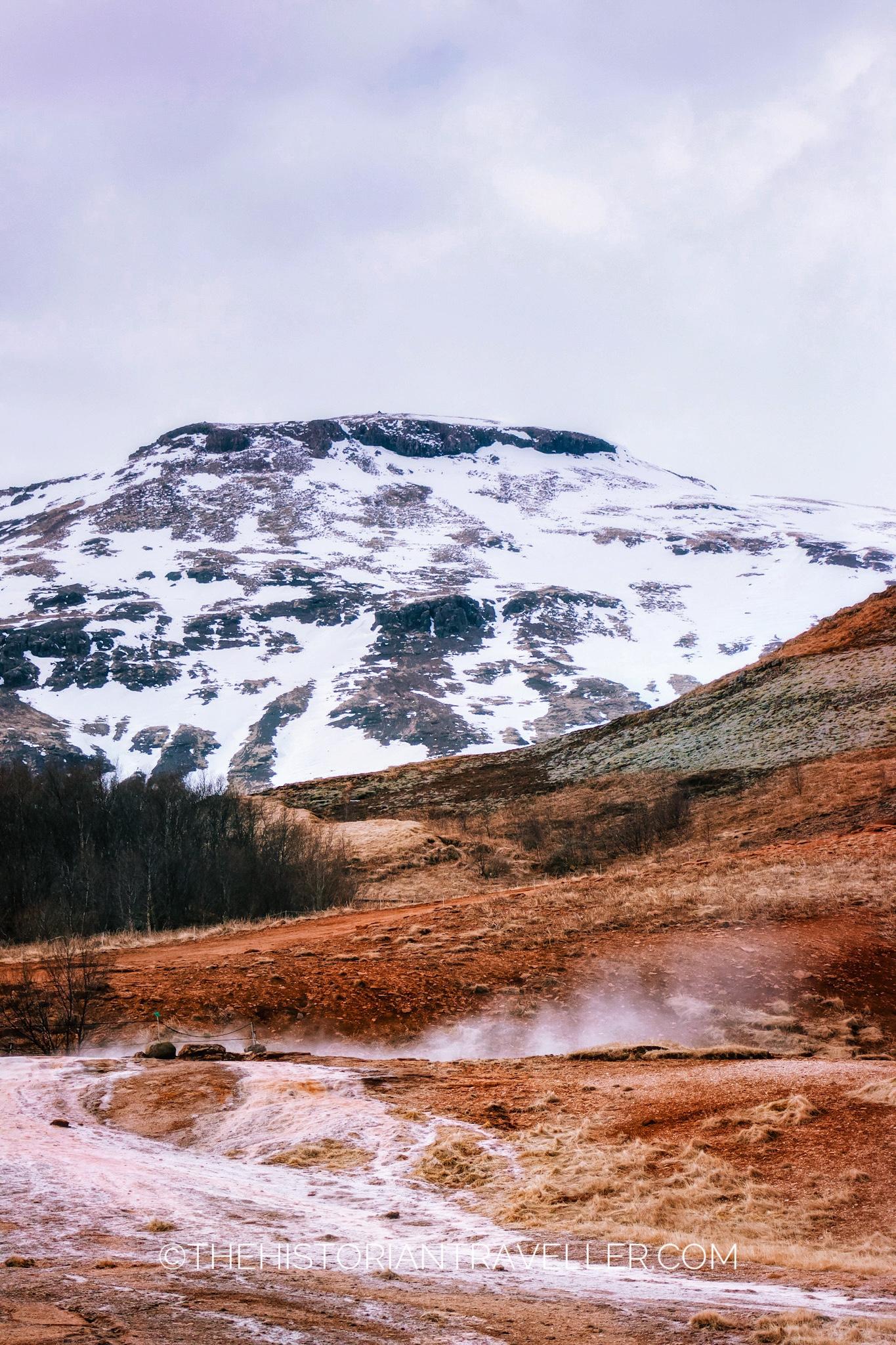
After dedicating most of your early morning to exploring the tectonic plates of Þingvellir, it’s time to head to the third major stop on the Golden Circle: the Geysir Geothermal Area. This is undoubtedly one of the most famous and iconic destinations on the Golden Circle, located in the Haukadalur Valley and easily accessible from Þingvellir.
During the spring and summer, you’ll immediately notice the area from the road, thanks to the vibrant minerals that lend the valley a multicolored appearance. As you get closer, the fumaroles emitting steam on the sides of the road will signal your proximity to the geysers. Yes, you read that correctly! This is one of the few places in the world where you can witness active geysers up close.
The Geothermal Area is approximately 60 kilometers from Þingvellir, and the drive takes about an hour to reach from the National Park. It’s important to note that this area can get quite crowded during peak seasons, and you may find yourself queuing for a parking spot, so plan accordingly.
Geysir and Strokkur
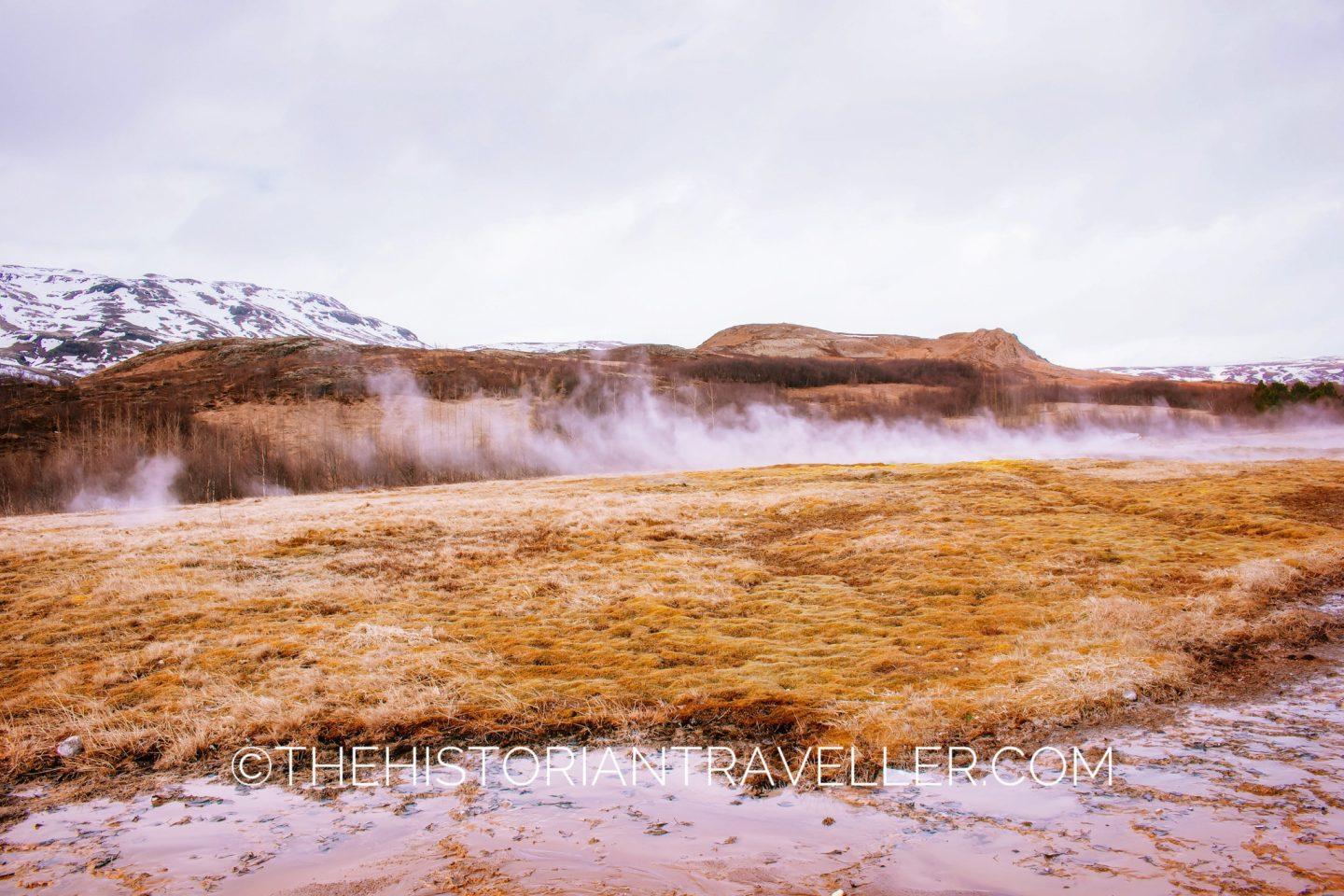
Icelandic geysers hold a unique place in history. Indeed, they are among the oldest known in literature. The Geothermal Area has been active for over 10,000 years, and it’s significantly influenced by the island’s seismic activity. Until 1845, the Great Geysir, from which the area derives its name, was highly active. There are reports of eruptions reaching up to 170 meters in height. However, after that period, Geysir became largely dormant due to the seismic activity on the island.
So, if you come across people waiting for more than 5 minutes by the side of the Great Geysir in hopes of witnessing its activity, you can safely disregard their efforts. That particular geyser is no longer active, and they are spending their time in vain. Instead, use that time to explore the valley and experience the area from different perspectives.
Conversely, the only active geyser you can observe today is Strokkur. It erupts approximately every 10 minutes, reaching a maximum height of around 30 meters. There are typically two types of eruptions: the first is quick and less powerful, which might initially leave you slightly disappointed. However, I strongly recommend patience. Indeed, after this initial outburst, you will likely witness the powerful and robust eruption you were anticipating. It’s well worth the wait!
Tip
When observing the geyser, be mindful of your position. If you stand too close, you run the risk of getting drenched during the eruption. To fully appreciate the landscape and the stunning colors of the valley, take some time to explore the other geysers in the area. The scenery is truly remarkable. Moreover, it’s an opportunity to witness the natural beauty of the region beyond just the geothermal activity.
Fourth stop, Gulfoss Waterfall.
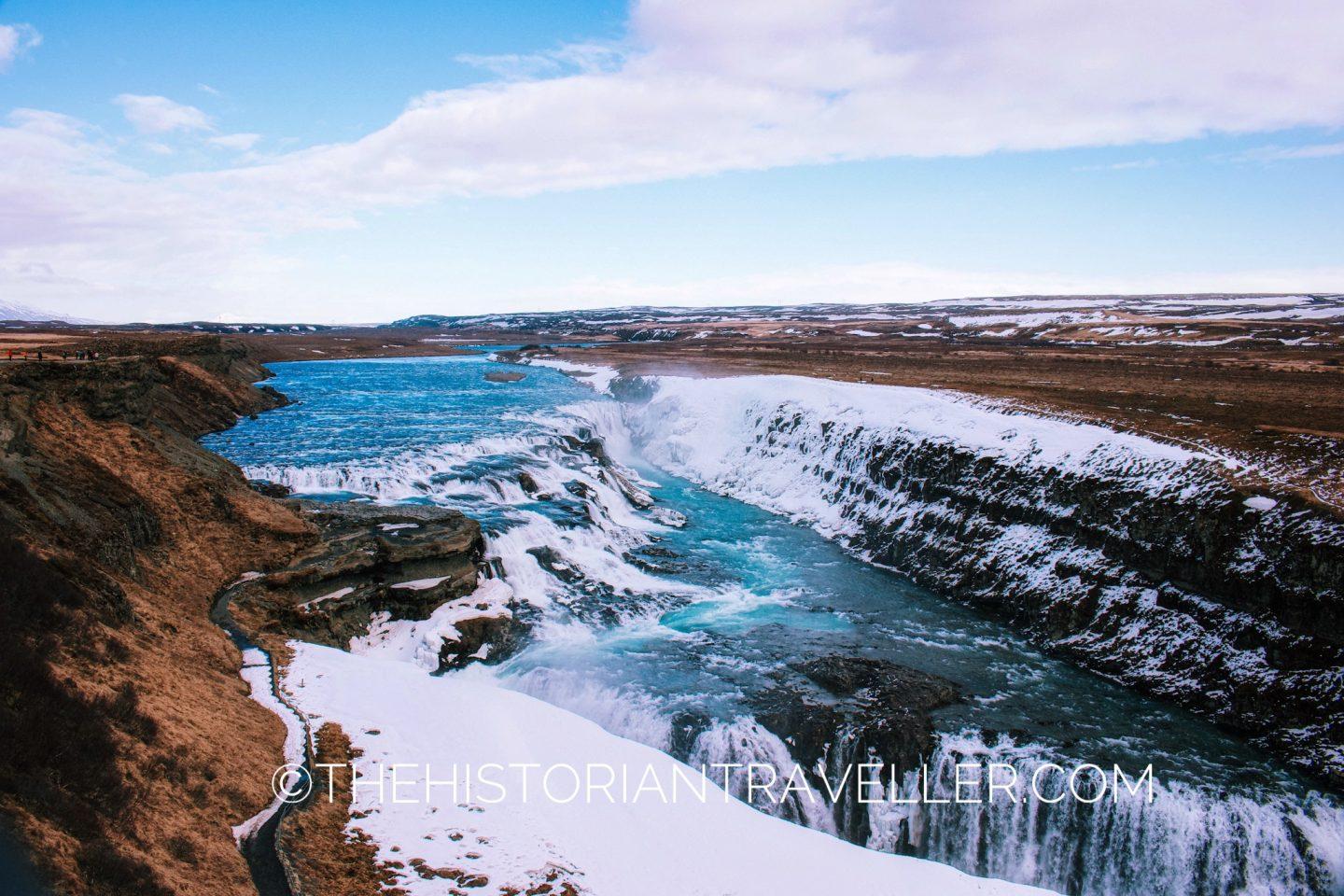
Gulfoss, meaning “Golden Waterfall” in Icelandic, marked our final stop before continuing our journey to Southern Iceland. This magnificent waterfall is situated at the top of the canyon on the Hvita river.
Gulfoss stands out as one of the most powerful waterfalls I’ve encountered in Iceland. Its might is not only due to the substantial volume of water flowing through it, averaging between 80 and 140 cubic meters per second, but also because of its sheer immensity. Indeed, the waterfall plummets from a height of approximately 32 meters. I realise the photos I’ve taken of this waterfall don’t make justice to this stunning location. Indeed, one has to see it in person to truly admire its power.
During our visit in late April, we discovered that Gulfoss was still partially frozen. This added a unique and captivating element to the experience, despite the challenges. However, it’s worth noting that the pathway running along the lower side of the waterfall was closed to visitors for security reason. If you visit during summer, this is an additional pathway you can take to explore the waterfall up-close.
Gulfoss brief history
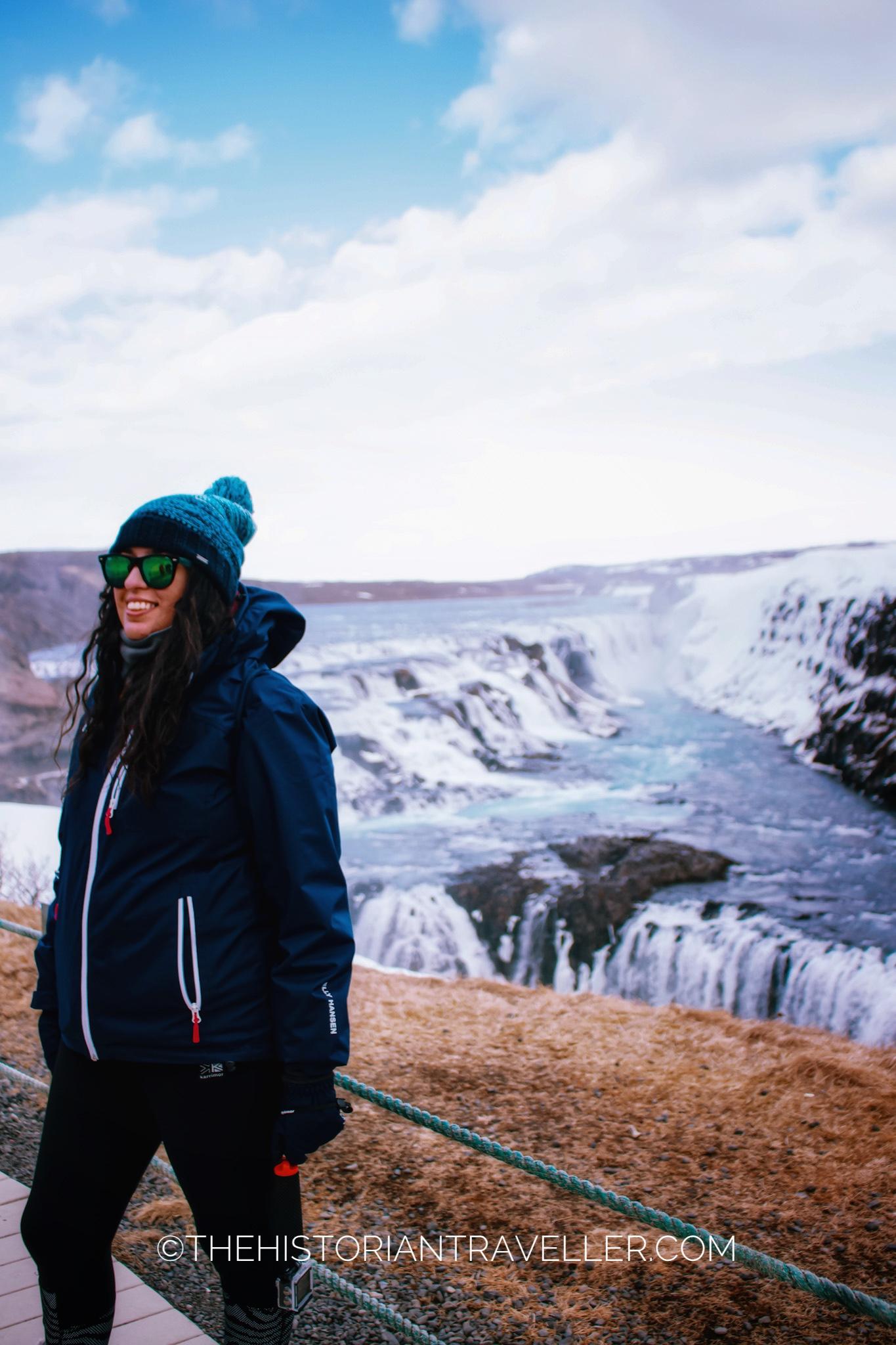
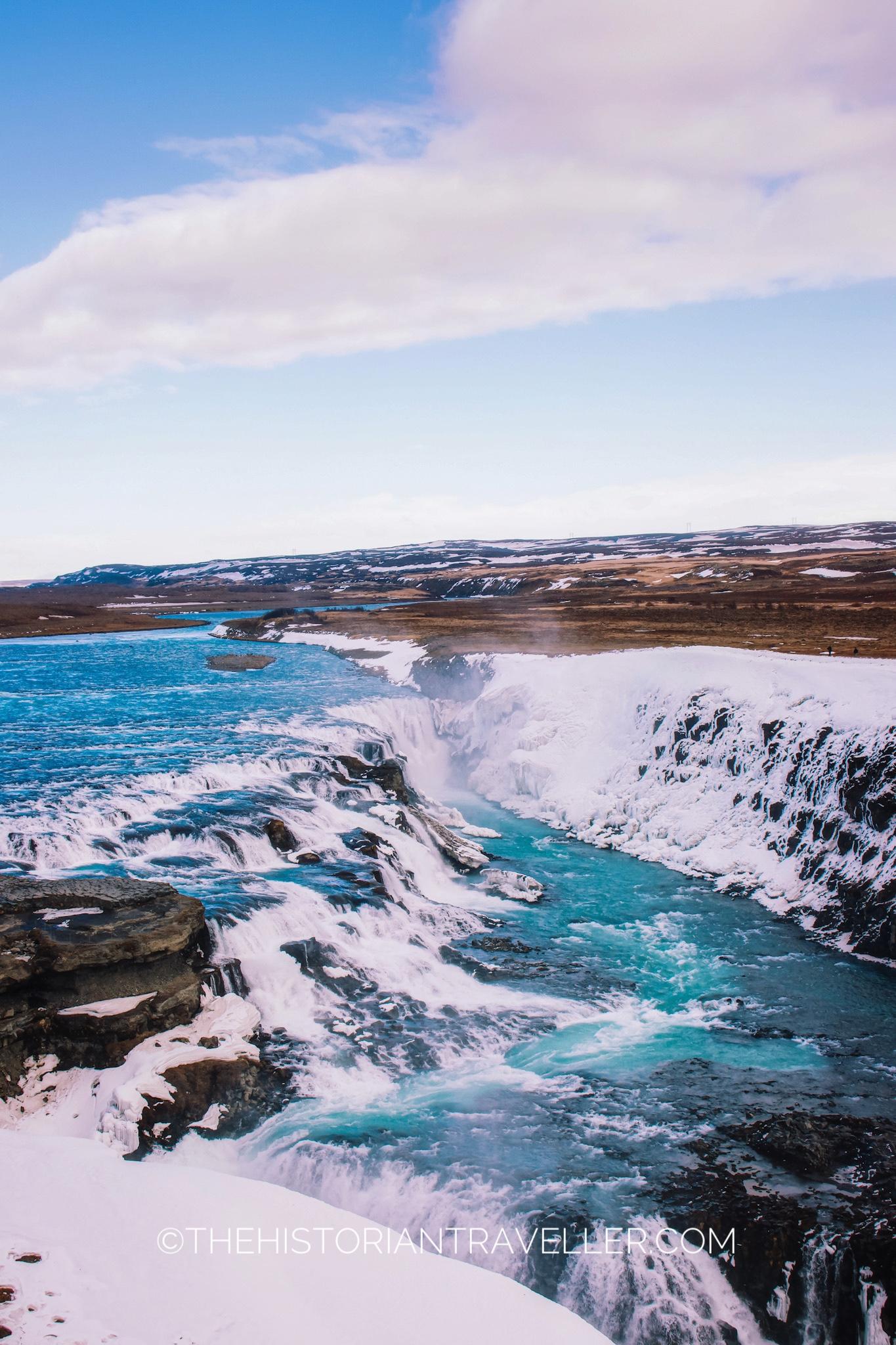
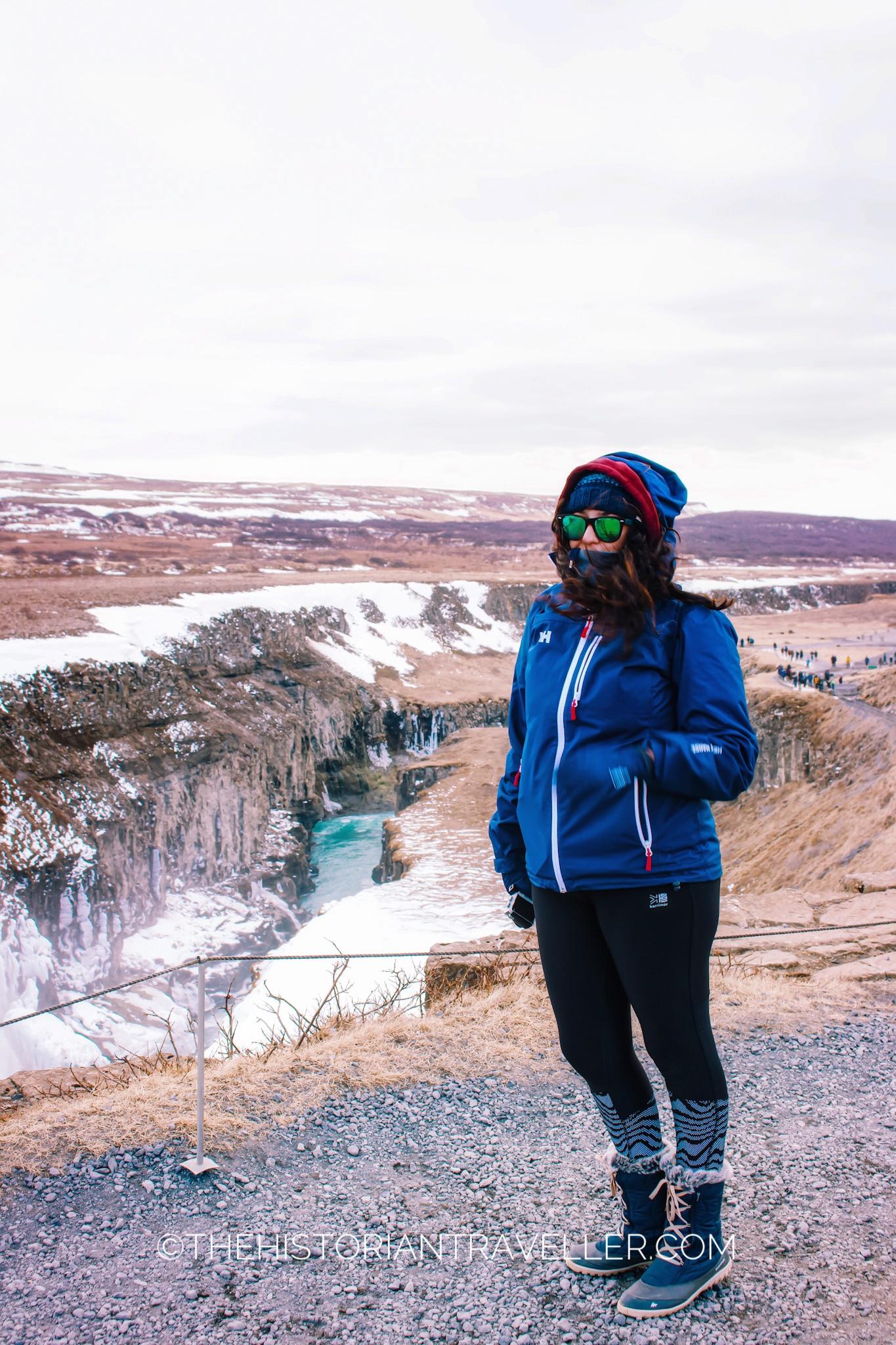
Gulfoss indeed had an interesting history. Until 1940, it was privately owned. Initially, there were plans to transform it into a local hydro-electric plant, but these plans were ultimately abandoned, thanks to the determined efforts of Sigríður, the daughter of the owner at the time, Tómas Tómasson. She vigorously advocated for preserving the untouched natural beauty of Gulfoss and, in the end, succeeded in protecting it. When the last owner eventually decided to sell the land and the waterfall, the government purchased it and established the present-day natural reserve, ensuring the continued preservation of this spectacular natural wonder. Sigríður’s dedication played a crucial role in safeguarding Gulfoss for future generations to enjoy.
Additional information for your Gulfoss visit
Gulfoss is located approximately 10 kilometers from the Geysir area, a short 10-minute drive by car. Surprisingly, despite the relatively short distance, I discovered that the climate and landscape in the two locations were remarkably different.
While the Geothermal Area offered a more pleasant temperature with a partially sunny sky, Gulfoss presented a starkly contrasting atmosphere. It was extremely cold, with strong winds and a partially overcast sky. Additionally, there was still snow and ice in the area, making it challenging to navigate around the waterfall. This highlights the variability of weather and climate conditions in Iceland, even during the spring season. It’s always a good idea to be prepared for a range of temperatures and weather patterns (I was wearing three jackets in the photos above!).
For those who haven’t stopped at the Geothermal Area’s services, you can find a smaller tourist center at Gulfoss. Here, you’ll discover a souvenir shop and a small cafe to replenish and warm up before continuing your journey.
Where to eat in the Golden Circle
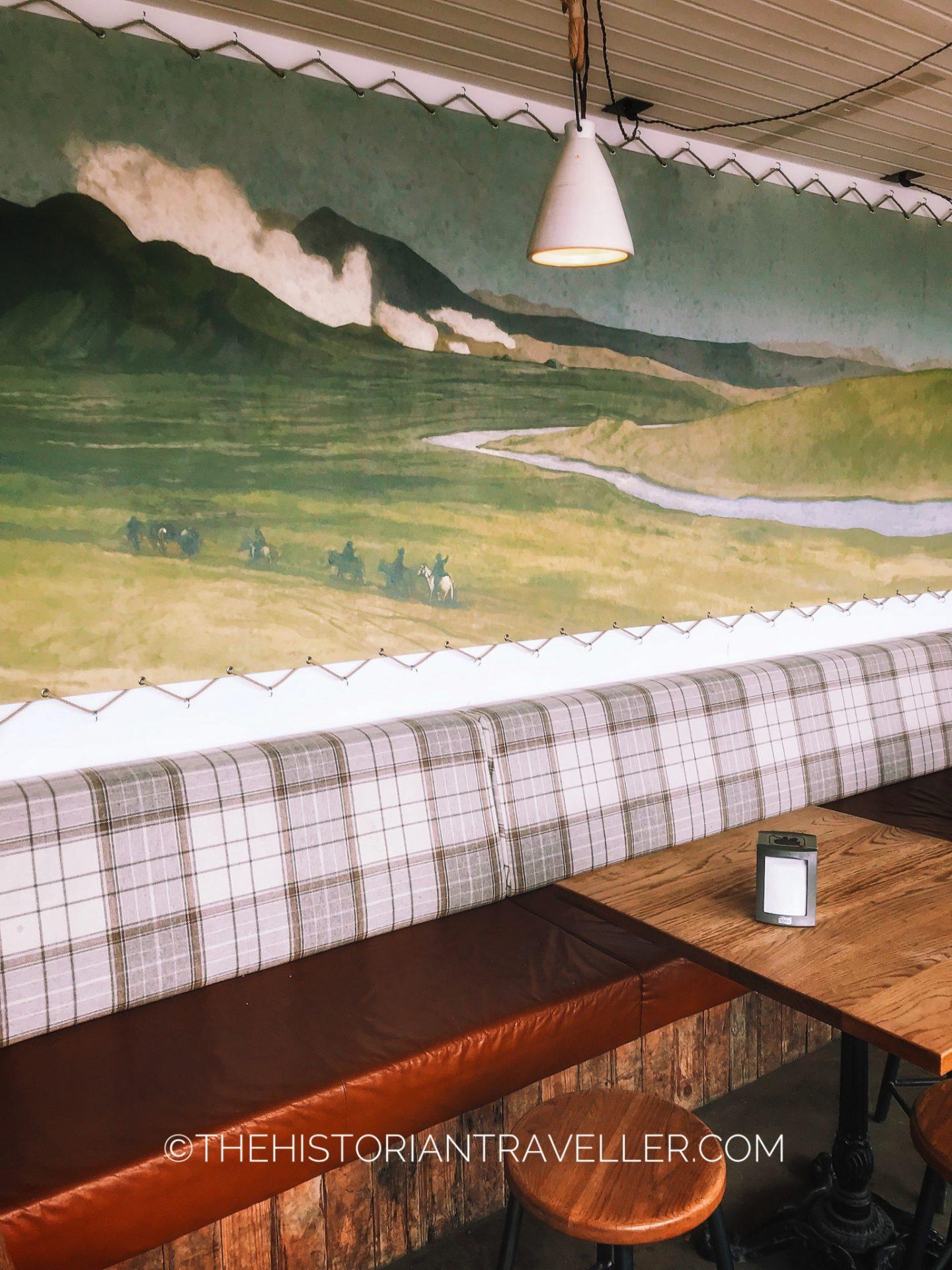
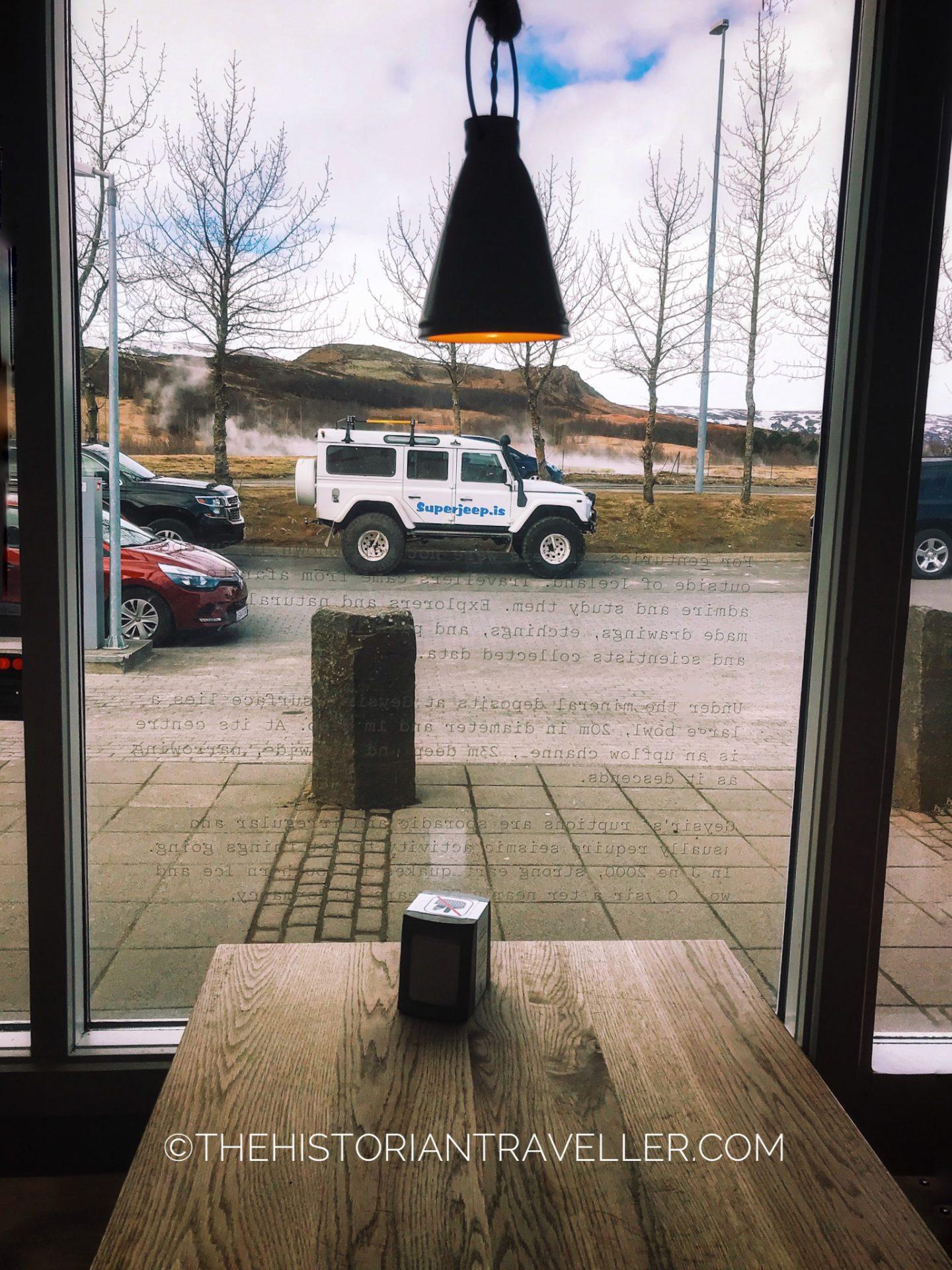
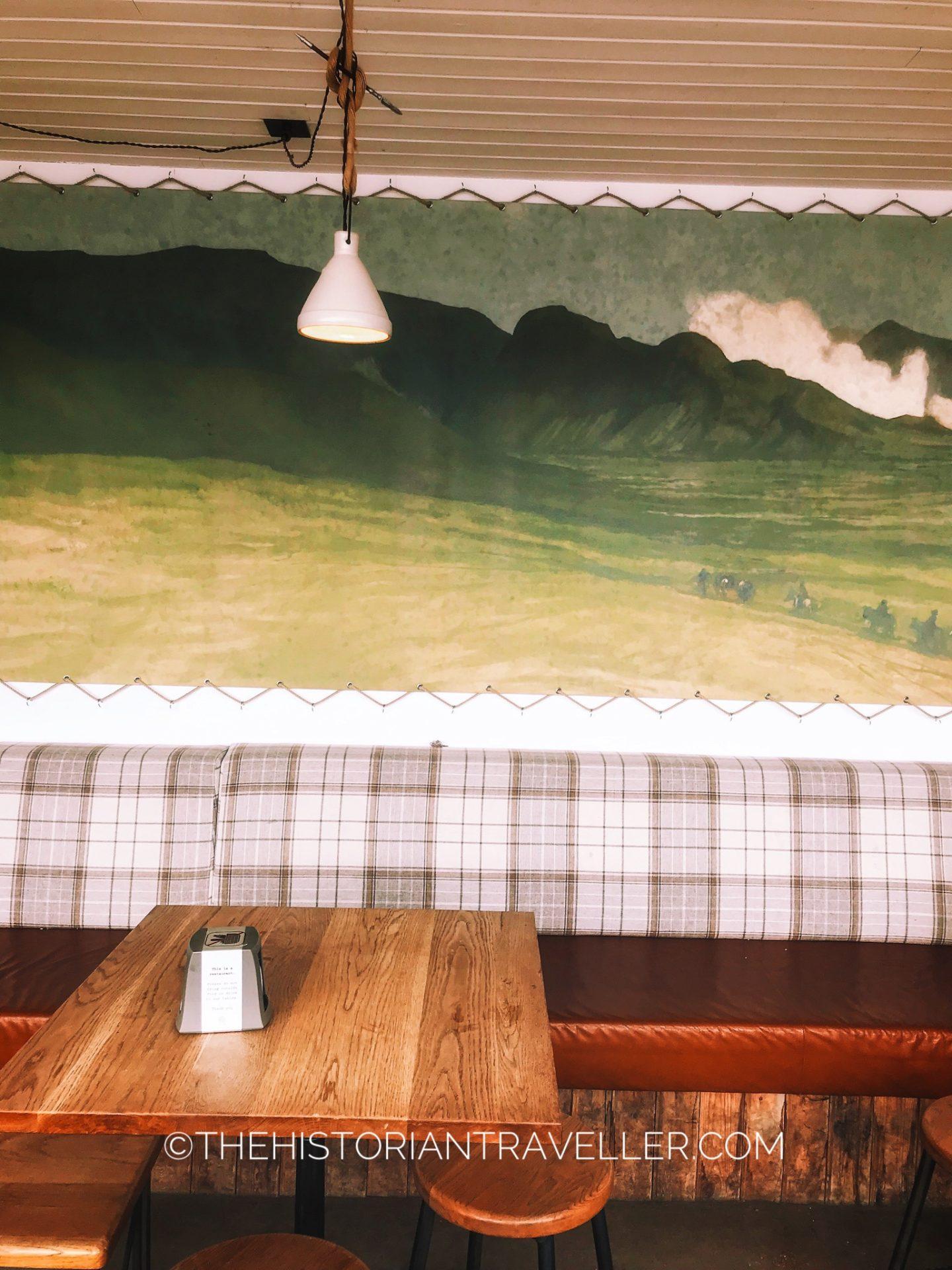
The Geothermal Area is likely to be one of the most crowded places you’ll encounter on the Golden Circle, and for good reasons. It not only features the fascinating geysers but also serves as the first stop on the route with available services. Right across from the geysers, you’ll find a Tourist Centre equipped with three restaurants, souvenir shops, and parking facilities.
We initially intended to have lunch at Friðheimar during our journey. Nevertheless, we ended up spending so much time taking photos of the incredible landscapes that it became quite late. Consequently, we opted to have lunch at the Tourist Centre, and we were pleasantly surprised. Not only did we find the food to be satisfying, but it was also unexpectedly affordable for Iceland. It’s a convenient option for a meal on the Golden Circle route.
Iceland golden circle itinerary additional stops
As mentioned earlier, our approach was to avoid rushing and focus on the main highlights of the Golden Circle. However, if you have more time to spare, you can certainly incorporate additional stops into your itinerary.
The map below illustrates my original, and admittedly ambitious, itinerary for exploring the finest spots on the Golden Circle. This includes also the additional spots you can consider for your visit. There are numerous beautiful places along this route that deserve a visit. I look forward to the opportunity to explore them during a second journey around Iceland. The country offers an abundance of natural wonders and scenic landscapes, making it a destination worth revisiting for a more comprehensive experience.
Golden Circle extensive itinerary suggested stops
- Kerið Crater – This is a volcanic crater lake located in the Grímsnes area. The Entrance fee is 450 ISK. More info here.
- Laugarvatn Fontana Geothermal Baths. Less crowded than the Blue Lagoon with stunning view on the lake. Entrance fee starts at 4.990 ISK for 2 hours experience. You can book your tickets here.
- Skálholt Cathedral (free entrance)
- Friðheimar Tomato and Horse Farm (restaurant – local cuisine). Booking in advance is mandatory.
- Secret Lagoon Hot Springs – Gamla Laugin. This places is famous as the oldest pool in Iceland. Enrance fee starts at 3300 ISK plus towel rent 900 ISK. Booking is recommended.
- Faxafoss ( or Faxi Waterfall). It’s a smaller version of Gulfoss. The waterfall is 80 m wide and 7 m high. The entrance is free.
- Sólheimar Eco-Village. Hosting about 100 people, this is the only eco-village in Iceland.
- Western Þjórsárdalur Valley. This is one of the most beautiful hiking routes in Iceland. It includes one of the highest waterfalls in the country, Háifoss (dropping at 122 mt) and several other natural attractions. It is recommended to explore this area on a separate day as it is quite extensive.
- Gjáin Waterfall (free entrance). Set on a scenic valley background this waterfall appears in Game of Thrones.
- Langjökull Glacier. Is the second largest glacier in Iceland. There are various view points and for a deeper exploration, tours are recommended.
- Rafting in Hvita river. This is an exciting activity to do at the foot of the Gulfoss waterfall. However, it is organised only during summer and via organised tours.
Plan your trip to Iceland
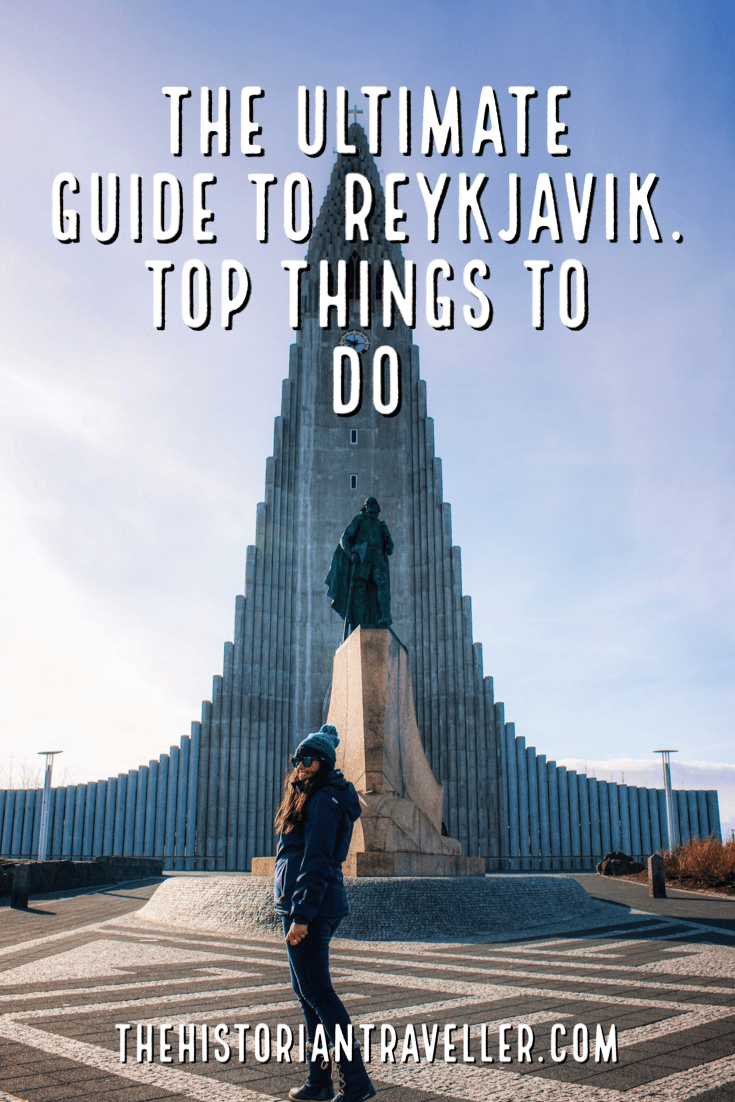
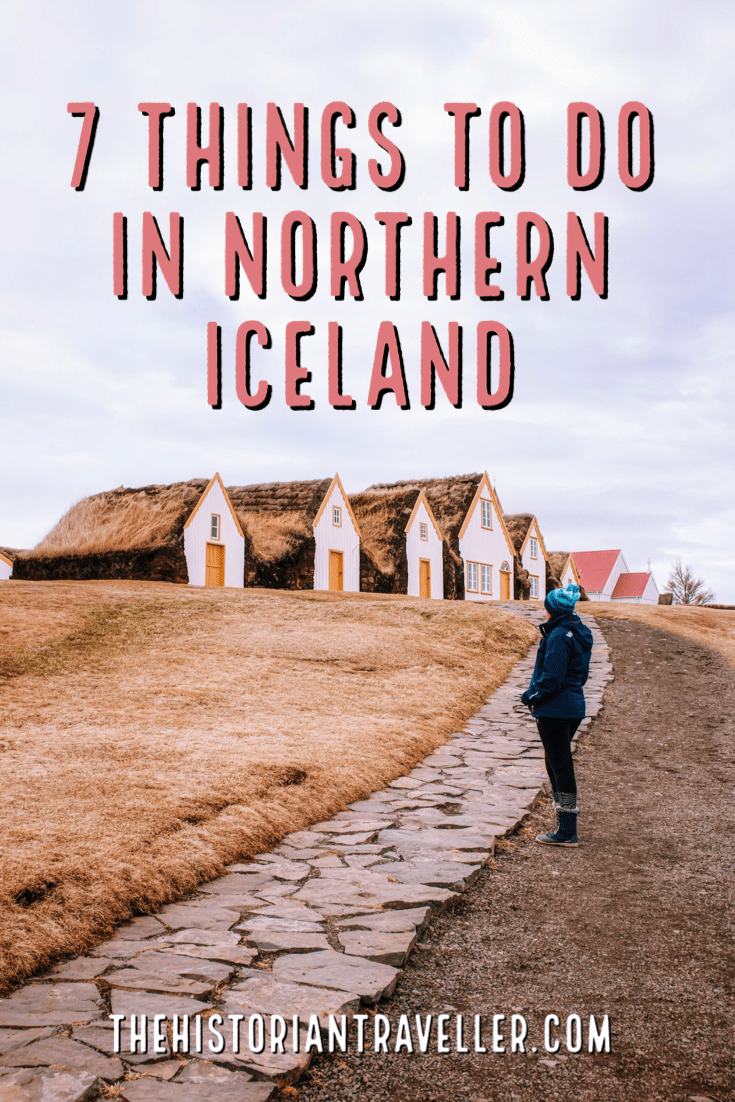
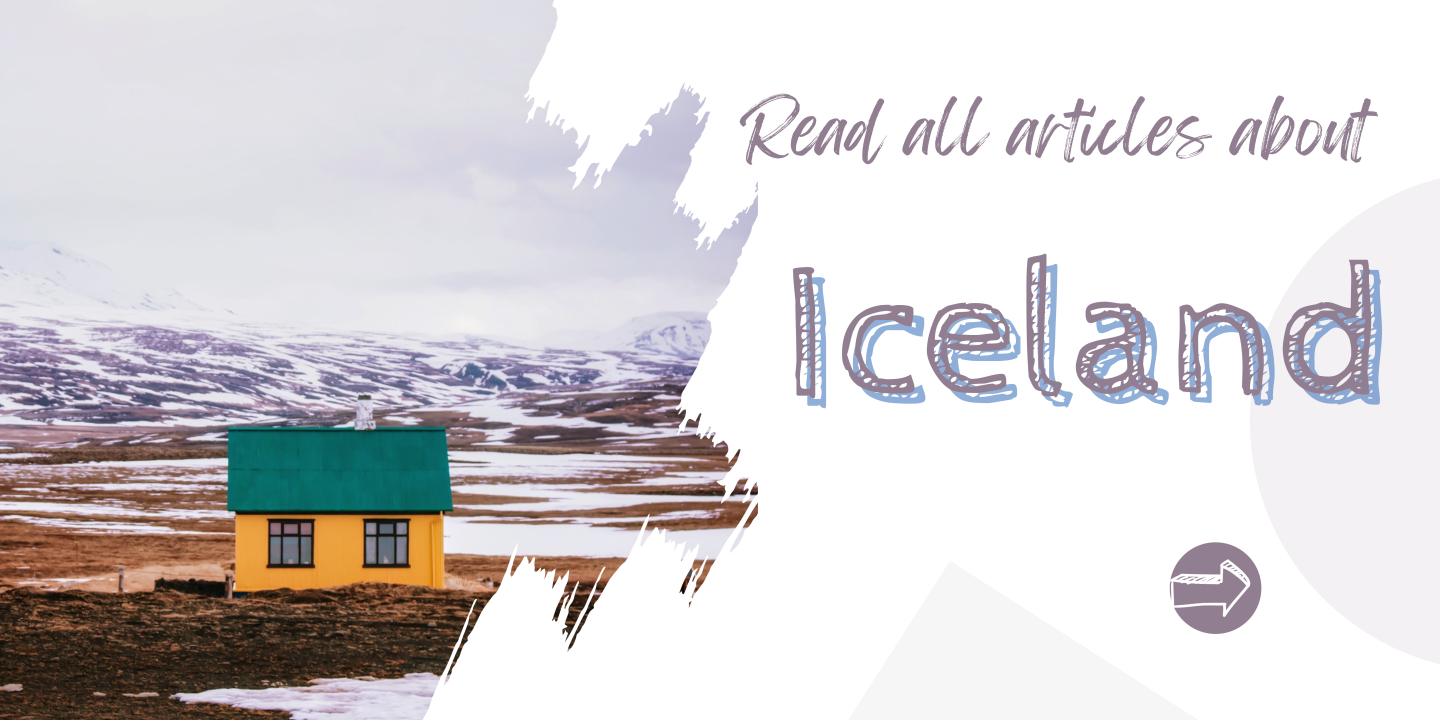
No time to read? Pin it for later!
